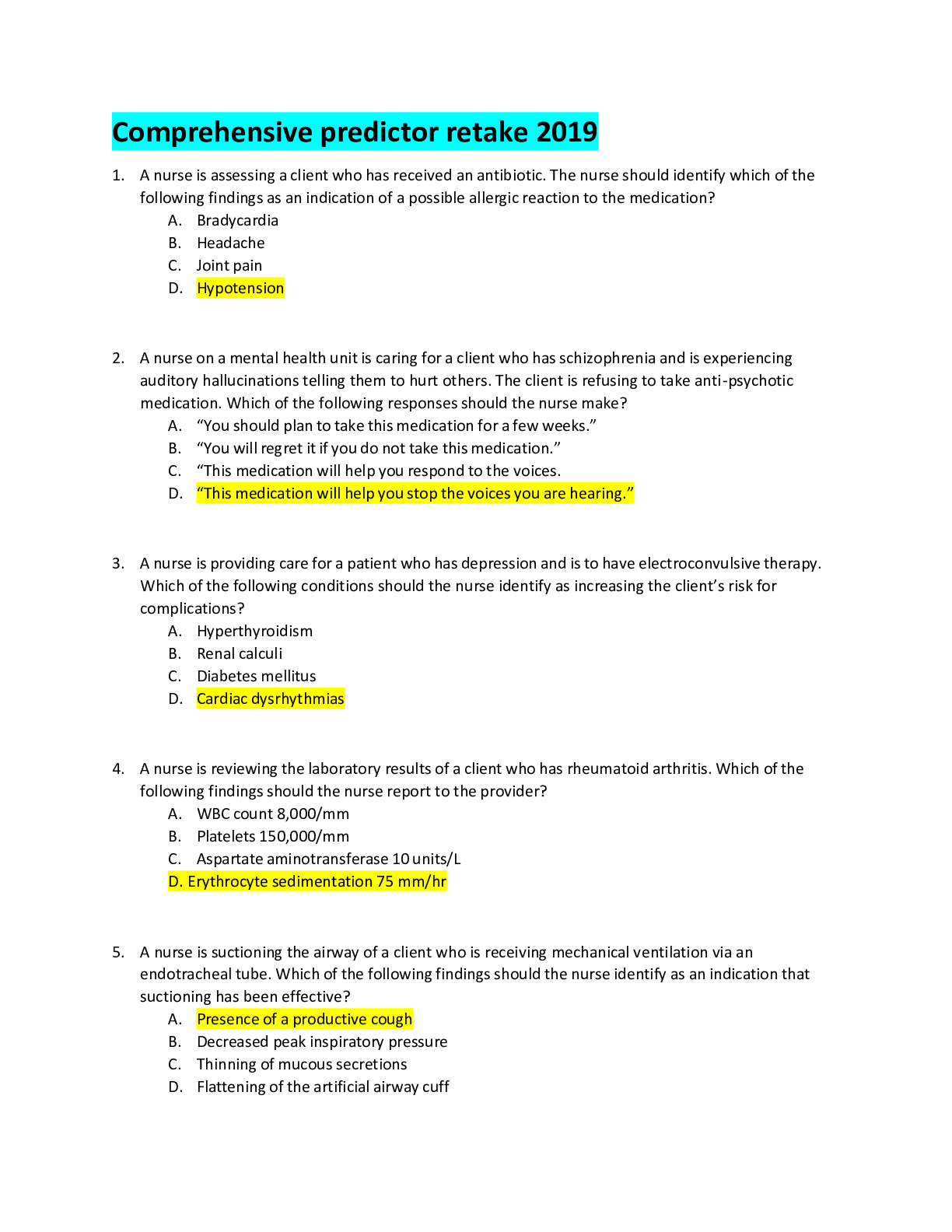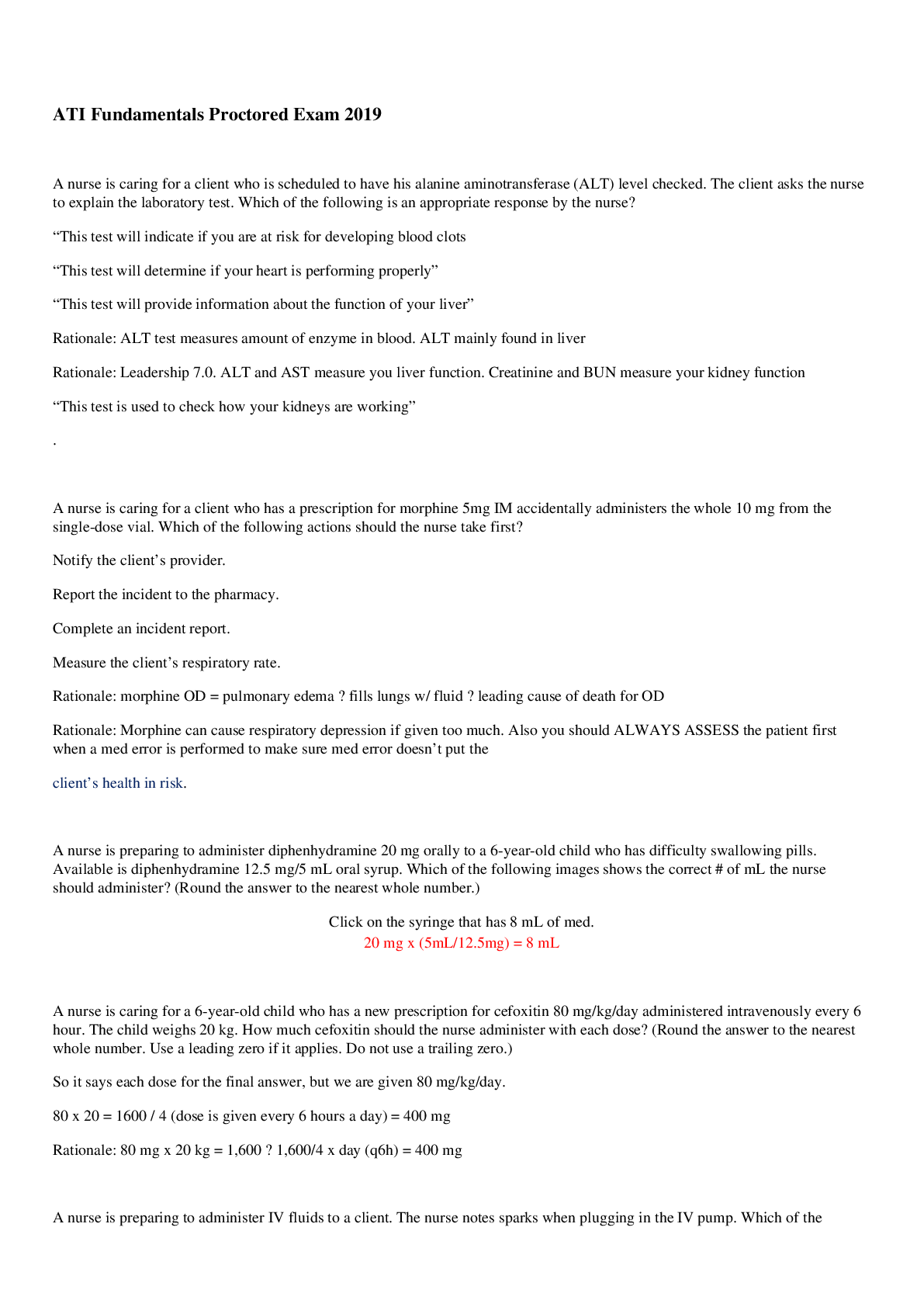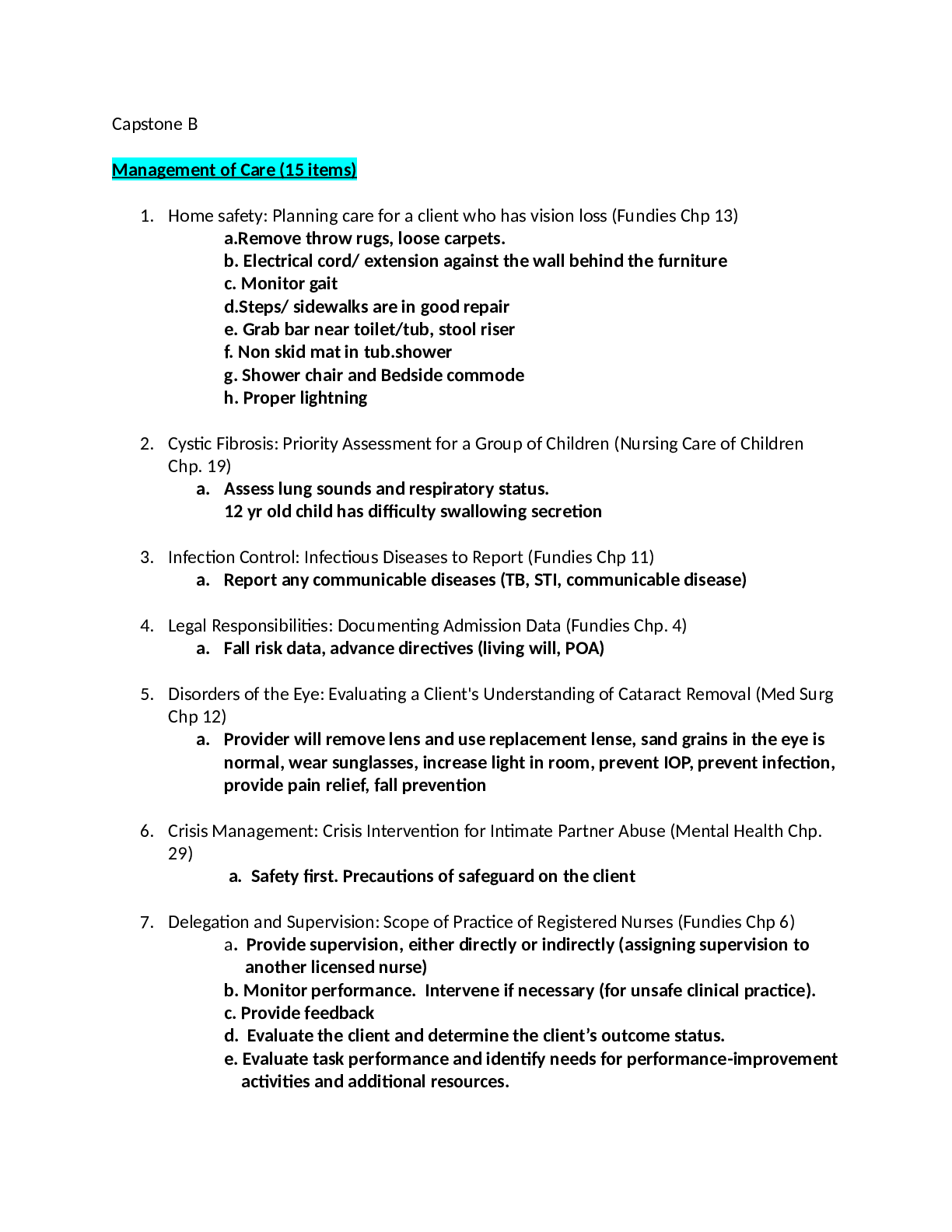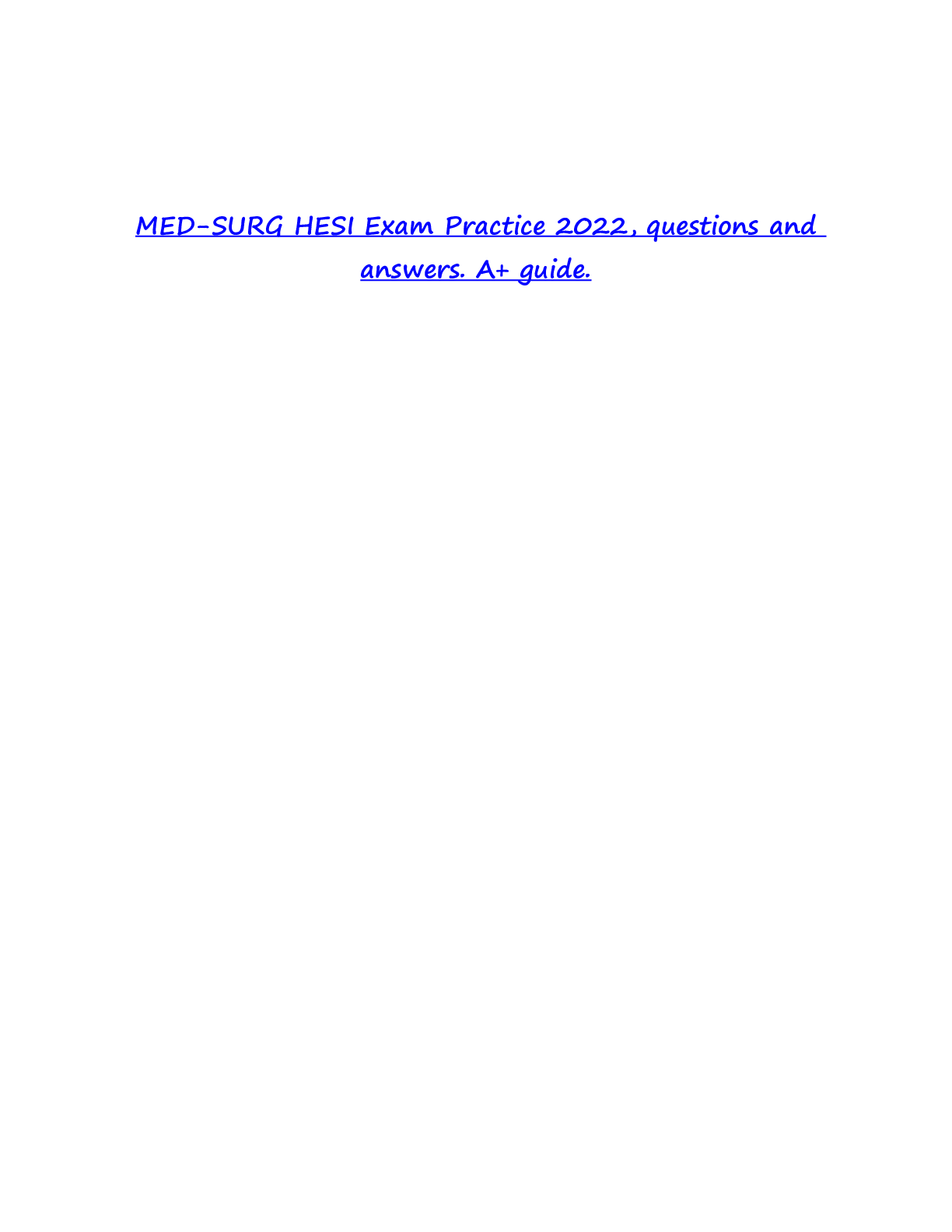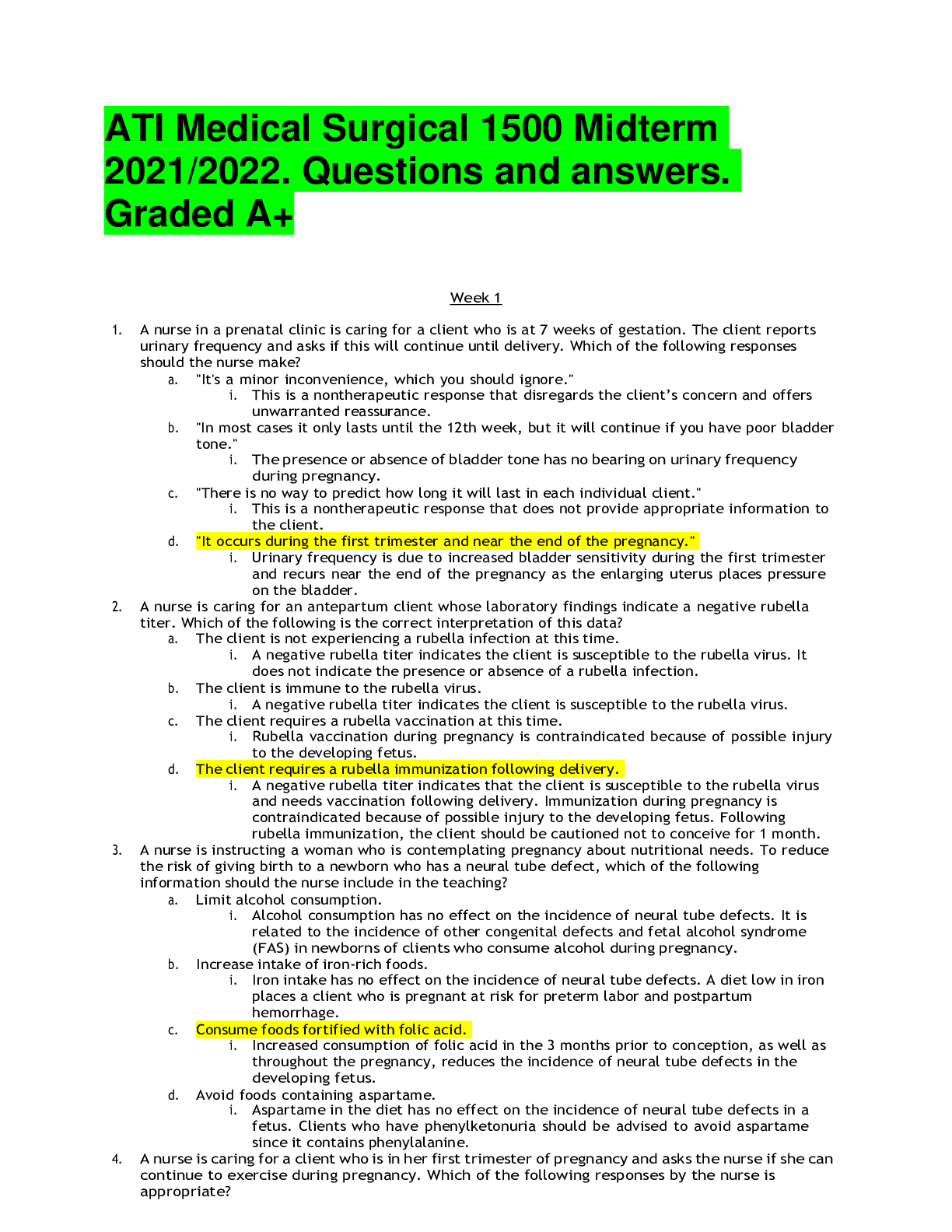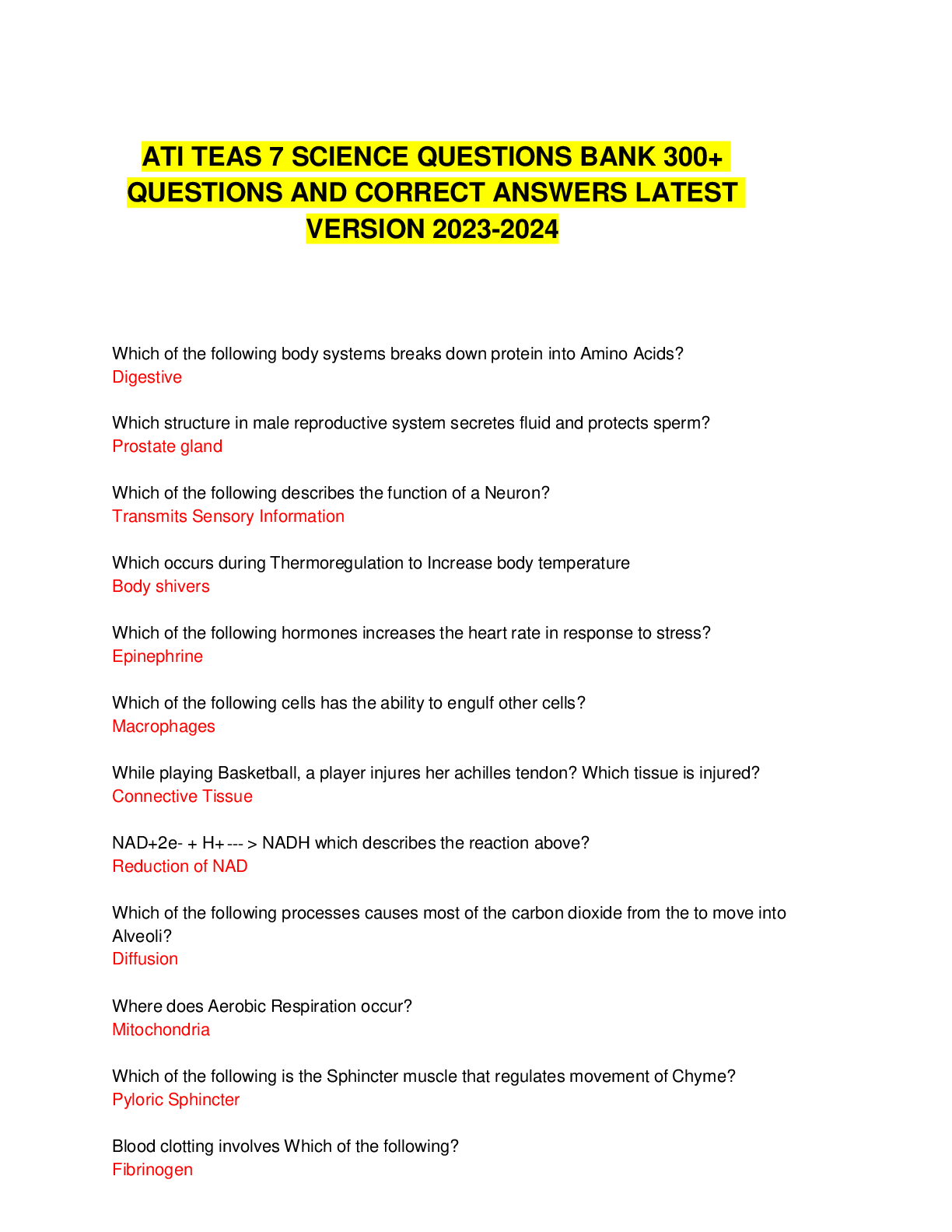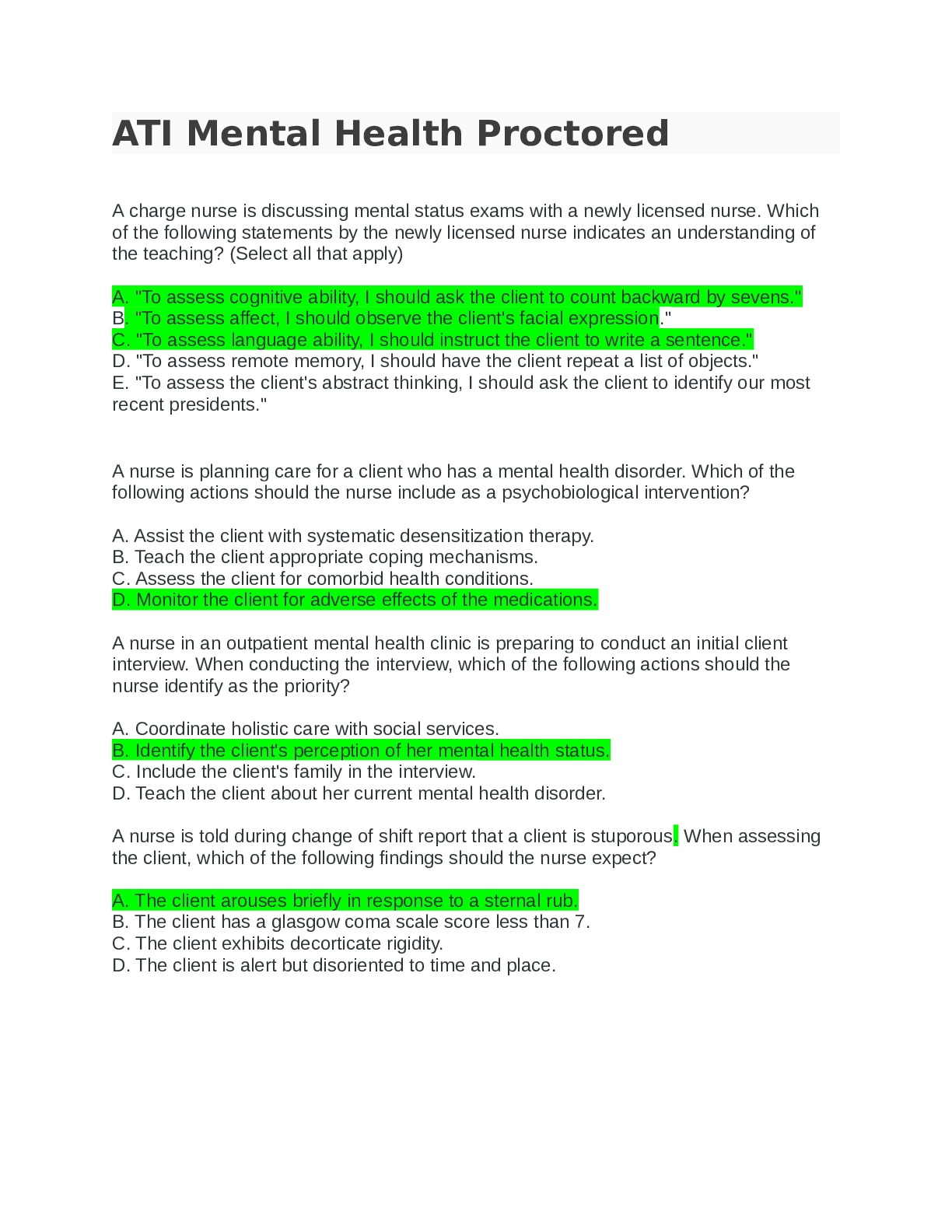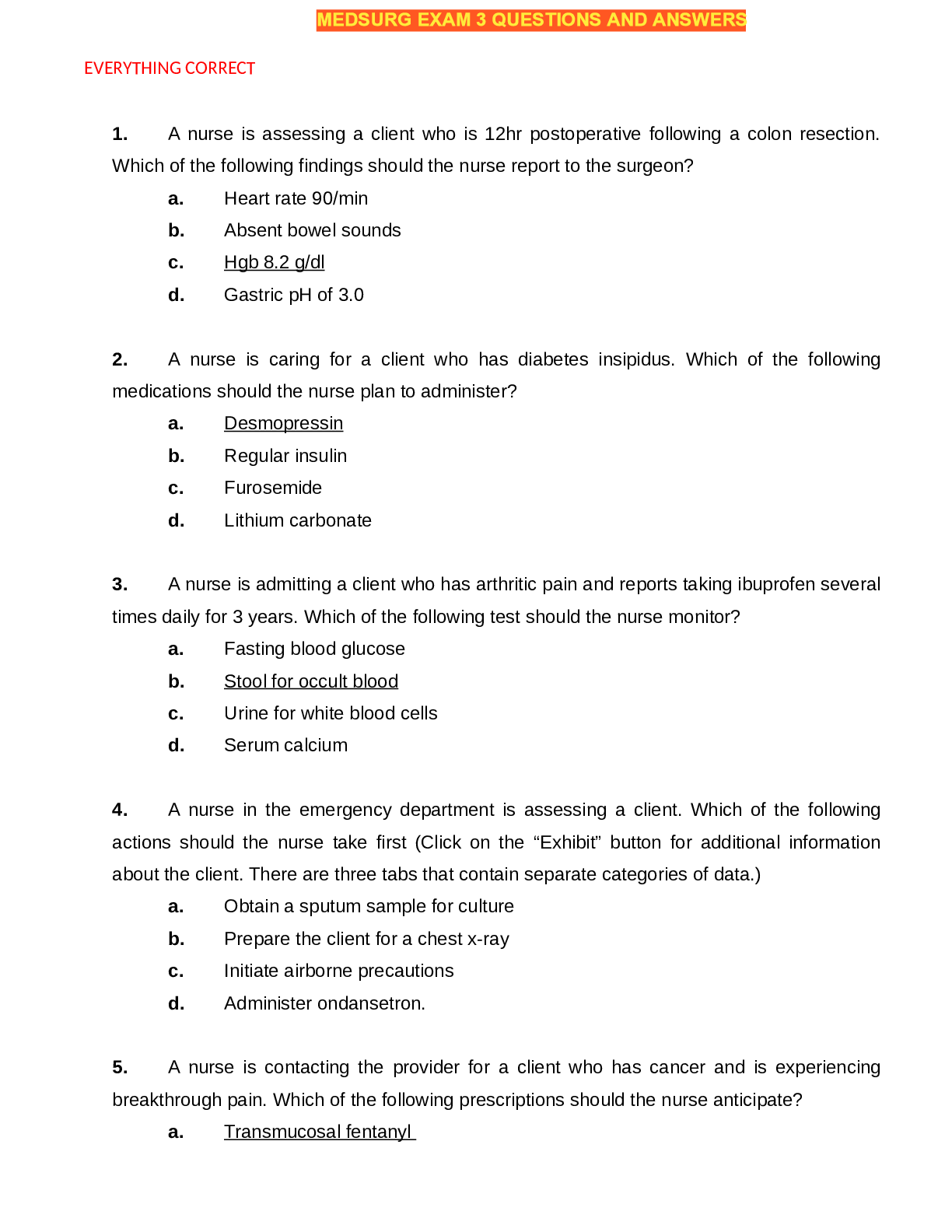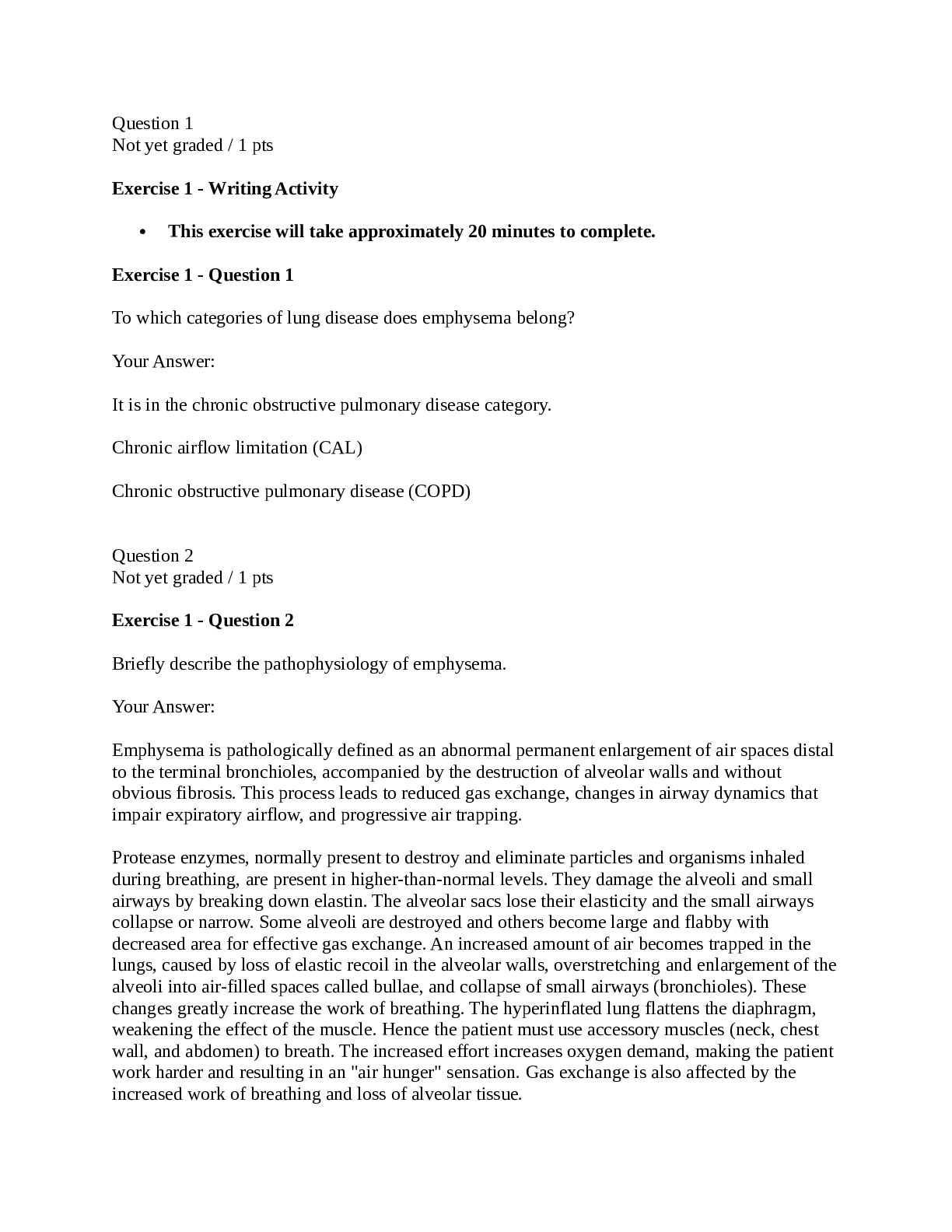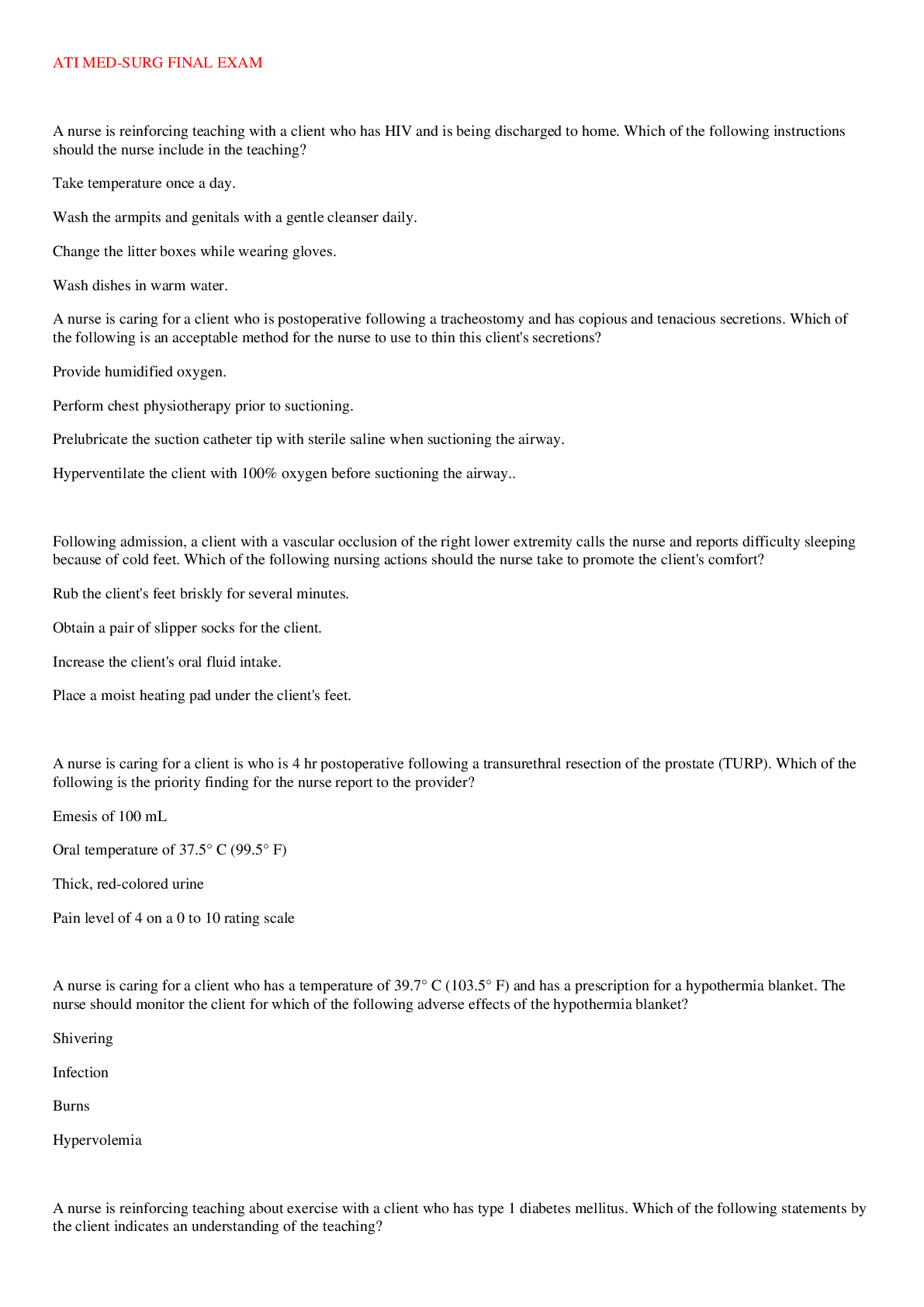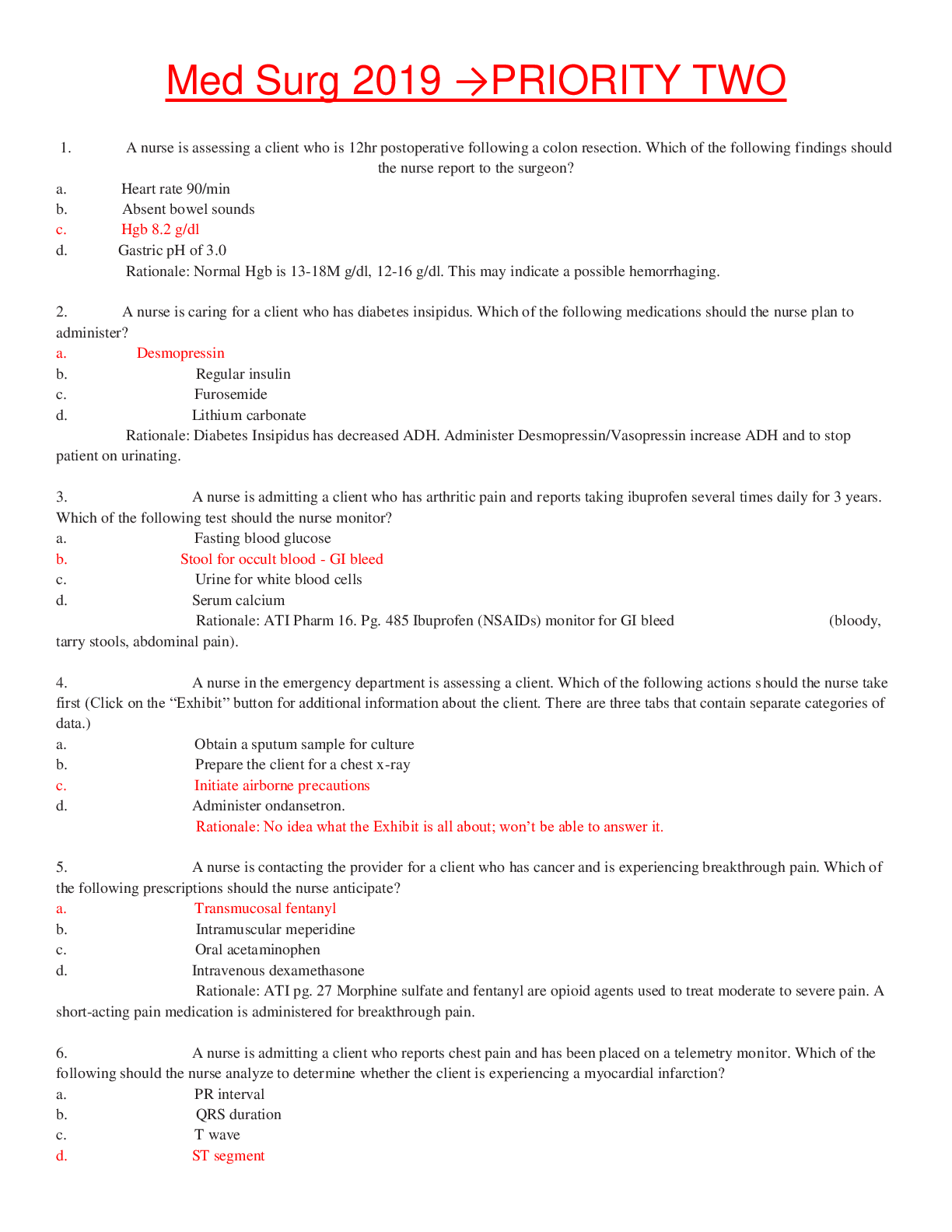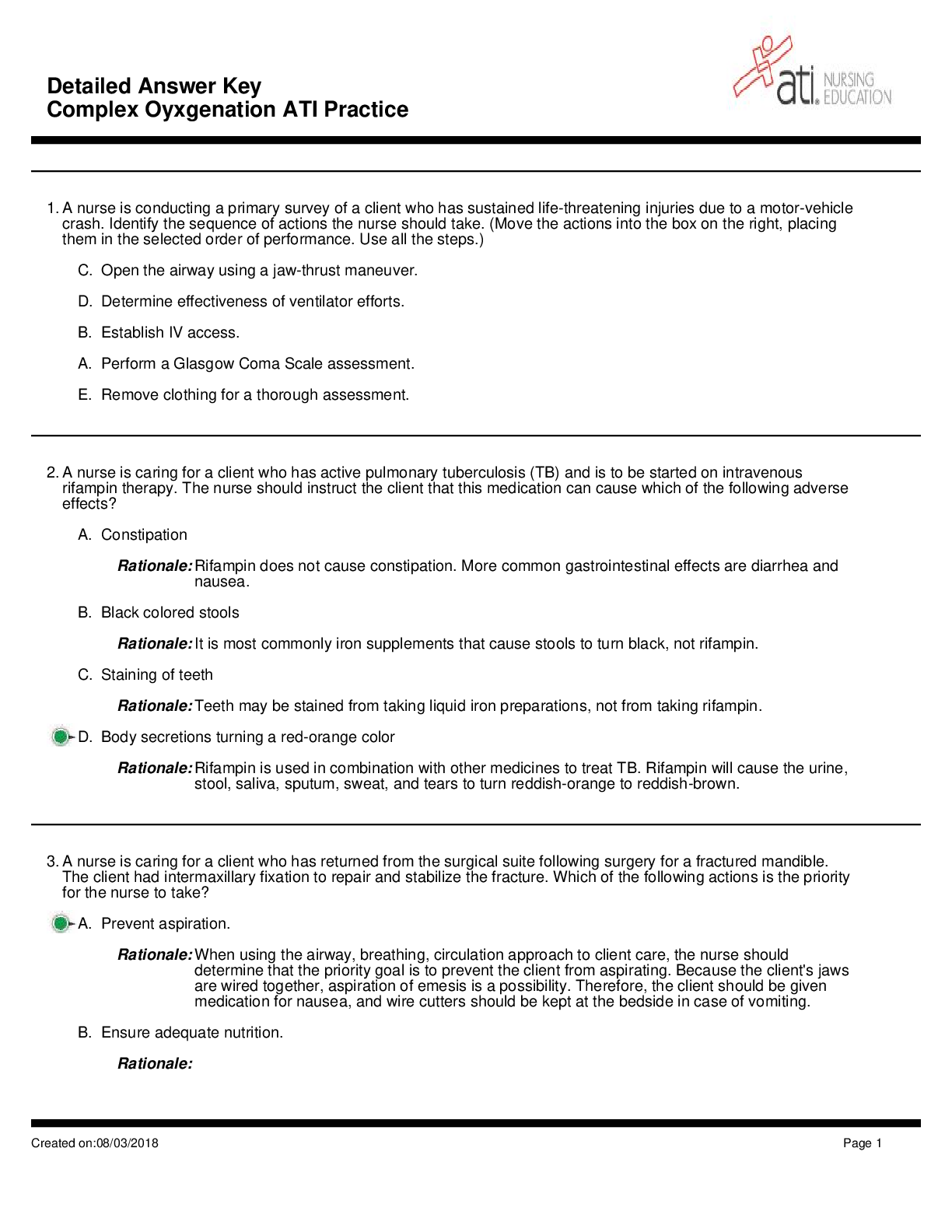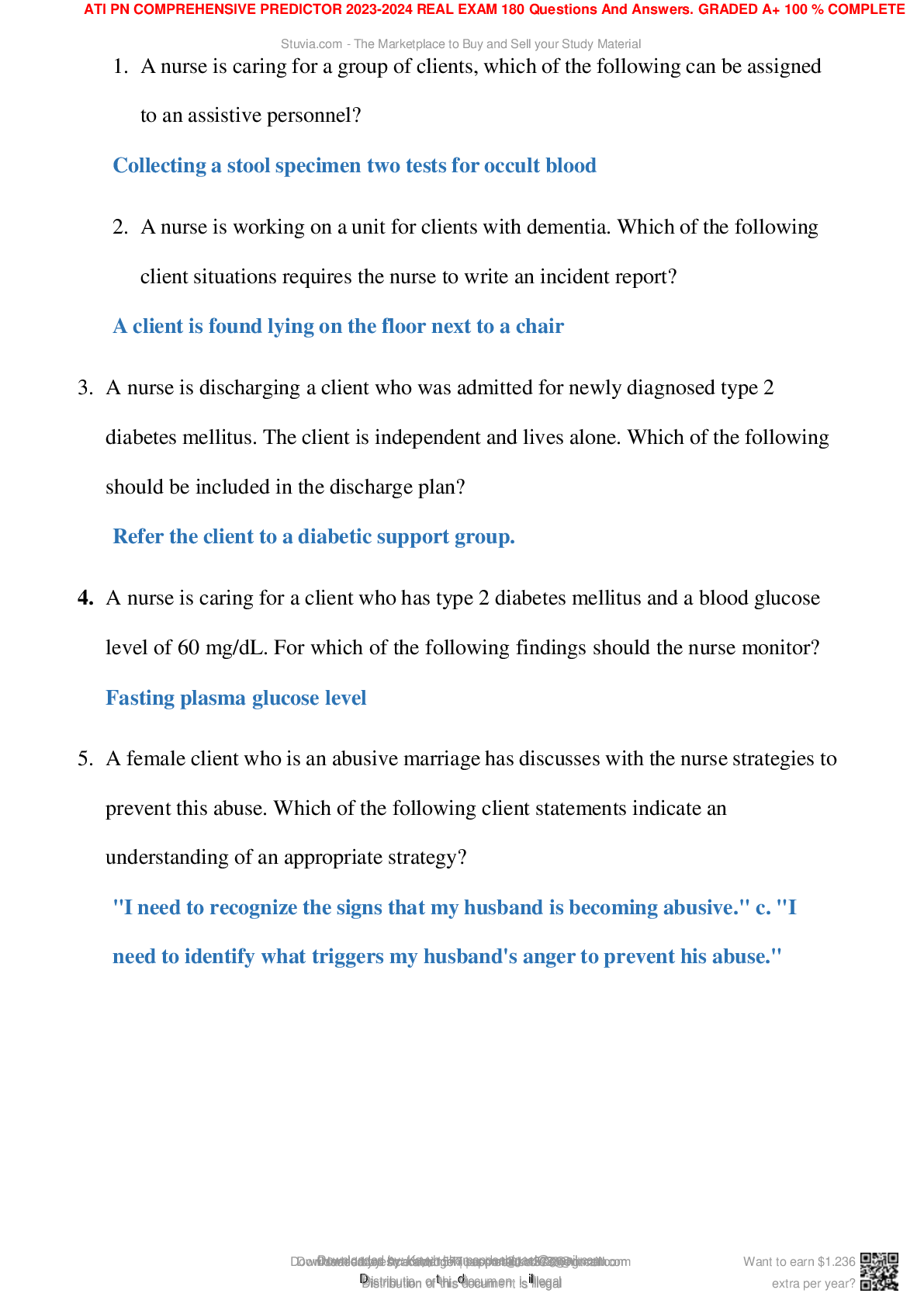*NURSING > ATI MEDICAL SURGICAL > ATI Comprehensive Predictor Version 2 Exit Exam NCLEX: Contains 150 of the regularly tested question (All)
ATI Comprehensive Predictor Version 2 Exit Exam NCLEX: Contains 150 of the regularly tested questions and Answers. Best for last minute/ quick exam study guide
Document Content and Description Below
Predictor Version 2 1. The nurse shows a teenager how to use a metered dose inhaler of ipratropium (Atrovent). Which statement, if made by the client to the nurse, indicates teaching is effective? 1. ... “I should use this medicine to stop the coughing that leads to an asthma attack” 2. “I should use this medicine if I begin to have an asthma attack” 3. “I should use this medicine right after I have an asthma attack” 4. “I should use this medicine to prevent an asthma attack” Answer#2 2. An older client is scheduled for a magnetic resonance imaging MRI procedure. Which of the following statements, if made by the client to the nurse, should be reported to the technician before the test? 1. “I take medication to control my blood pressure” 2. “I have had diabetes for about 10 years now” 3. “I had a knee replacement 5 years ago” 4. “I am allergic to penicillin and sulfa medications” Answer#3 3. The nurse makes the following observations of a 6 hour old newborn: axillary temperature 96.4 F (35.8 C), apical pulse 148, respirations irregular at 48/minute, black sticky stool, blood glucose 60mg/dL. It is most important for the nurse to take which action? 1. Feed the newborn 30mL of infant formula 2. Administer low flow oxygen to the newborn 3. Wrap the newborn in a warmed blanket 4. Perform a guaiac test on the newborns stool Answer#3 4. A client is returned to the unit at 10AM after laparoscopic gallbladder surgery. The nurse plans to get the patient out of bed for the first time at 4PM. It is MOST important for the nurse to take which of the following actions? 1. Turn the patient from side to side at 2 PM 2. Offer pain medication to the patient at 3:30PM 3. Encourage the patient to use the incentive spirometer at 3PM 4. Cough and deep-breathe the patient at 2:30PM Answer#1 5. The activity therapy staff takes a group of psychiatric patients on a trip to the zoo. The nurse should intervene with which of the following patients before their departure? 1. A 50 year old female who is having difficulty with sleeping, eating, and social interaction. 2. A 40 year old male who just received his third dose of trazodone (Desyrel) and is 20 pounds overweight. 3. A 42 year old female who has problems with decision making who pacescontinuously, wringing her hands. 4. A 38 year old female who is receiving chlorpromazine (Thorazine) and is wearing a sundress without a hat or sunglasses. Answer#4 (photosensitivity;causes sensitivity to sun) 6. A patient experiences skin eruptions due to an allergic reaction to a medication. The nurse demonstrates the BEST documentation with which of the following? 1. “Patient complains of rash and itching over most of his body. Patient is concerned about how it looks” 2. “Multiple red welts noted over trunk and both arms. Patient states that welts itch” 3. “Allergic skin reaction to medication experienced by patient. Started several hours ago” 4. “Vital signs stable. Patient scratching arms and chest area frequently” Answer#2 7. An older client diagnosed with emphysema is admitted to the psychiatric unit for treatment of bipolar disorder. The client receives oxygen per nasal cannula. The client expresses concern to the nurse that someone will come in and change the amount of oxygen the client is receiving. INITIALLY, the nurse should take which of the following actions? 1. Schedule an in-service with the staff about emphysema 2. Place a sign above the patient’s bed stating that the oxygen level is not to be changed 3. Tell the patient she will be well cared for in the hospital 4. Convey the patient’s concern to the nursing staff Answer#2 8. A teenager has a positive home pregnancy test and comes to the prenatal clinic. The girl is uncertain of the date of her last menstrual period. The nurse palpates the uterine fundus midway between the symphysis pubis and the umbilicus. Which statement by the nurse is BEST? 1. “You are 24 weeks pregnant. It is good that you came in for prenatal care” 2. “You are 30 weeks pregnant. Prenatal care is important for you and your baby” 3. “You are 16 weeks pregnant. Let’s talk about what that means” 4. “You are 8 weeks pregnant. Are your periods usually irregular?” Answer#3 9. A client is admitted to the psychiatric unit with complaints of fatigue, inability to concentrate, lack of appetite, and repetitive thoughts. The client is reluctant to take the prescribed medications, fearing that they are harmful. After the nurse gives the client the medication, the nurse should take which of the following actions? 1. Instruct the client to open her mouth and move her tongue up and down and to each side while the nurse looks inside. 2. Ask the client if she has swallowed the medication completely. 3. Watch the client’s behavior to see if the medication is having its desired effect.4. Observe the clients throat while she swallows several times after putting the medication in her mouth. Answer#1 10. The nurse assesses a patient 72 hours after a total joint replacement of the right hip. Which finding requires an intervention by the nurse? 1. There is a pillow between the patients legs 2. The patient’s legs are internally rotated 3. The patients hip joint is flexed at a 70 degree angle when the patient sits in the chair 4. The patient has not requested pain medication for 12 hours. Answer#2 (prevent internal or external rotation, that means se safó) 11. A client newly diagnosed with Meniere’s disease plans a trip to an amusement park with the family. The client asks the clinic nurse which of the following rides is best. The nurse should suggest which of the following rides? 1. Roller coaster 2. Merry go round 3. Ferris wheel 4. Train Answer#4 12. A client is discharged from the hospital after coronary bypass (CABG) surgery 3 days ago. During discharge teaching, the client asks the nurse “When can I resume sexual intercourse with my wife?” it is best for the nurse to make which of the following statements? 1. “You can resume sexual activity when you feel strong enough” 2. “You can resume sexual activity when you are able to walk one block without chest pain or discomfort” 3. “You may have difficulty maintaining an erection because of your recent surgery” 4. “You should abstain from sexual activity because it may be detrimental to your recovery” Answer#2 (one block or two flights of stairs without chest pain) 13. A woman complains to the nurse about the care provided to her husband by the nursing staff the previous night. Initially, the nurse should take which of the following actions? 1. Ask the wife to voice her expectations about a solution to the problem 2. Gain consensus with the woman on the specific steps that will be taken care for her husband 3. Explain to the wife that the problems she identified will be fixed 4. Notify the wife that everything possible is being done for her husband Answer#1 14. A patient is restrained bodily by the nursing team. The hands of the nurse assigned to hold down the patients leg should be placed in which of the following positions? 1. One hand on the patients knee and the other hand on the patients ankle2. One hand directly above the patient’s knee and the other hand directly above the patient’s ankle 3. Both hands side by side on the patients thighs 4. One hand at the patients groin and the other hand at the patients mid-calf area Answer#2 15. The nurse in the community mental health center works with a client who is diagnosed with depression. Cognitive therapy is initiated. The nurse should take which of the following actions? 1. Assist the client to review past intellectual achievements 2. Help the client develop more positive thoughts 3. Help the client to identify the source of his depression 4. Change the client’s values and beliefs. Answer#3 Cognitive Therapy; determined that how individuals feel and behave is determined by how they think about the world and their place in it. 16. The nurse plans to perform a physical assessment of a young adult who has been deaf since birth. Although the client indicates using sign language, no interpreter is available. The nurse should take which action? 1. Face the client and speak slowly using low-pitched voice 2. Write out each question, and ask the client to write out each answer 3. Sit on the clients right side and use gestures and nonverbal clues 4. Show the client pictures of the parts of the body that will be examined Answer#2 17. A patient received morphine 4 mg IV 2 hours ago for the complaints of postoperative pain. The patient turns on the call light and tells the nurse he has to go to the bathroom. The patient has bathroom privileges. The nurse should take which of the following actions? 1. Obtain a bedside commode for the patient to use 2. Provide a warmed fracture bedpan for the patient to use 3. Tell the patient to breathe deeply as he walks to the bathroom 4. Ask the patient sit on the side of the bed before proceeding to the bathroom Answer#4 18. The nurse cares for a patient on the psychiatric unit with a history of drug use and poor impulse control. After the patient’s mother visits, the patient begins pacing rapidly, with arms swinging, and kicking at chair legs. The nurse should approach the patient and take which of the following actions? 1. Sit in a chair several feet away from the patient and lean forward with hands clasped together 2. Stand facing the patient with legs apart, knees locked, and weight on back leg 3. Sit in a chair next to the patient and lean back with arms folded 4. Stand facing the patient, legs together, knees locked, with weight on both legs Answer#219. The nurse observes the nursing assistant giving morning care to an elderly client who has an area of warm, reddened skin on the sacrum that does not blanch with pressure. Which action by the nursing assistant requires an intervention by the nurse? 1. The aide cleanses and then applies A and D ointment to the reddened area 2. The aide firmly massages the reddened area in a circular motion 3. The aide placed a piece of sheepskin under the patients sacrum 4. The aide positions the patient on the left side with head of the bed flat Answer#2 (Stage I pressure ulcer, do not massage can damage capillary beds and cause tissue necrosis) 20. The school nurse identifies several children who have food allergies. Which sequence should the nurse teach the staff to follow if an allergic reaction is observed in a child? 1. Call 911, call the physician, administer EpiPen, call the parents 2. Administer the EpiPen, call 911, call the physician, call the parents 3. Call the physician, administer the EpiPen, call 911, call the parents 4. Call the parents, administer the EpiPen, call the physician Answer#2 21. A client comes to the ER complaining of shortness of breath, fatigue, insomnia, and weight loss. The client states that the client’s company forced the client into early retirement. The client says that the client has been sick ever since the client stopped working. The nurse should take which of the following actions first? 1. Encourage the patient to find outlets for his job skills in a consultative or volunteer basis in the community 2. Help the client see a connection between his symptoms and emotions, while investigating each symptom 3. Tell the client that anger is an unacceptable reason to something being taken away 4. Explain to the client what retirement should be like, and contrast this with what he has experienced Answer#2 22. The nurse teaches the woman diagnosed with type 1 diabetes who is pregnant for the first time. The nurse teaches the client that as the pregnancy advances, the client may require which implementation? 1. Decreased amounts of insulin 2. Increased amounts of insulin 3. Decreased amounts of carbohydrates in her diet 4. Increased amounts of protein in her diet Answer#2 23. The nurse cares for a patient after a colon resection. The patient has a Salem sump tube connected to intermittent suction. The patient asks the nurse, “When will I be able to eat?” Which is the BEST response by the nurse? 1. “You will be given a high-calorie, high-fiber diet in a few days” 2. “You will be started on clear liquids when we hear your stomach make noises”3.”You can eat food when the NG tube is removed in about 5 to 6 days” 4. A soft diet will be given to you after you have your first bowel movement” Answer#2 24. The nurse supervises care provided for a client immediately after cardioversion. Which observation, if made by the nurse, indicates the need for an intervention? 1. A cold cloth has been applied to the paddle sites on the patient’s chest 2. The patient’s dentures remain in a cup at the bedside 3. There is an NPO sign above the patients bed 4. The oxygen the patient was receiving before the procedure remains disconnected Answer#4 25. The nurse cares for a client diagnosed with bursitis of the right shoulder. The nurse expects the client to experience which of the following? 1. Pain and numbness in the first two fingers and thumb of her right hand 2. Spasms of the right hand when a blood pressure cuff is initiated and left in place for 2 minutes 3. A constant dull ache originating in the neck and radiating down the right arm 4. Pain with extension, flexion, and internal rotation of the right arm Answer#4 26. The nurse supervises care provided by the nursing assistive personnel (NAP) to the older client in the convalescent phase after a stroke. The nurse should intervene if which action is observed? 1. The client is supine with a pillow under the head 2. The client is positioned laterally on the left side with the head of the bed flat 3. The client sits with the head of the bed elevated and the knee gatch up 4. The client is positioned laterally on the right side with the head of the bed flat Answer#1 (Brain attack or CVA; keep head unaffected side, no neck flexion or extension, head of bed flat) 27. The nurse cares for a client who is receiving amitriptyline (Elavil) 25 mg q A.M. and 100 mg at HS. The nurse understands that the medication schedule will accomplish which of the following? 1. Make therapeutic use of an expected side effect of the medication 2. Decrease interference between digestion of food and absorption of medication 3. Utilize the increased permeability of the blood-brain barrier that occurs during sleep 4. Reduce the side effects experienced by the client Answer#4 (Antidepressant, tryciclic; it has a sedative effect, administer larger dose at night it causes increased sedation) 28. An older patient falls on the floor of the psychiatric unit. To determine the cause of the fall, it is MOST important for the nurse to do which of the following? 1. Check the patients eyeglasses2. Examine the condition of the patients shoes 3. Monitor the patients’ blood pressure 4. Evaluate the floor where the patient fell Answer#4 29. The nurse instructs a prenatal class for first-time mothers. A group of mothers state they are afraid because they have heard that babies often die in their sleep before their first birthday. The mothers ask what they can do to prevent this. It is BEST for the nurse to make which of the following responses? 1. it’s important for you to focus on your pregnancy and upcoming labor and not to focus on negative things that may happen in the future 2. This does not happen very often. With good nutrition and loving care your babies should thrive and develop normally 3. Unfortunately, the cause of this condition is not definitely known, so there is little you can do to prevent this from happening 4. It’s best to position the baby on its back or side in bed. There seems to be an increase in this condition when babies are put to sleep on their stomach Answer#4 30. A client attends a support group for incest survivors at the community mental health center. The client tells the nurse, “I don’t get it. People keep telling me I talk just like my father. He’s the last person I’d want to act like!” which response by the nurse is BEST? 1. Genetically, you are like your father 2. You need to be more open-minded. I’m sure your father had some good qualities 3. Don’t worry about what everyone else is saying 4. Sometimes people unconsciously take on the characteristics of people who exert power over them Answer#4 To exert is to apply or use. Waleska=mami 31. The family of a patient admitted to the psychiatric unit 3 days ago arrives for a visit carrying two suitcases. The nurse informs the family that before they can proceed into the unit, the suitcases need to be searched. The family asks why this needs to be done. Which is the BEST response by the nurse? 1. “We know what is best for our patients” 2. “We have to make sure you’re not bringing contraband” 3. “Were just following the rules established by administration” 4. “Things that you may not think of as being harmful may be used for harm by the patient Answer#4 32. The nurse asks the nursing assistant to obtain morning vital signs on several patients. It is best for the nurse to make which of the following statements? 1. “Go check the vital signs for the patient in rooms 321 and 322. Record your findings on this sheet and then return it to me” 2. “Today you’ll check patient’s vitals. Please start with rooms 321 and 322. Be sure towrite them down” 3. “Since you have been taught to check vital signs for patients, you can take them on patients in rooms 321 and 322. Let me know your findings” 4. “The patients in room 321 and 322 need to have their morning vital signs taken. This allows us to compare the results to what the night nurse documented.” Answer#1 33. The nurse reviews basic communication skills with a new group of nursing assistants. It is BEST for the nurse to make which of the following statements? 1. “Understanding nonverbal behavior assures success in interpersonal relationships 2. “Nonverbal behavior is best considered in combination with verbal communication” 3. “There is no specific meaning for each type of nonverbal behavior” 4. “Altering nonverbal behavior is a form of manipulation” Answer#2 34. The nurse cares for a woman at 7 months gestation diagnosed with preeclampsia. The client comes to the outpatient clinic for her weekly checkup. The nurse is MOST concerned if which of the following is observed? 1. The clients temperature is 98.2 F (36.7 C) 2. The client has 2+ pitting edema of her feet 3. The client gained 1 pound since the last visit 4. The client’s skin is dry Answer#2 35. A client with a history of arterial insufficiency is seen in the outpatient clinic. The client complains to the nurse about frequent awakenings during the night because of a burning numbness in the lower extremities. The nurse should advise the client to take which of the following actions? 1. Elevate the legs on several pillows 2. Get up and walk around the room 3. Place the legs in a dependent position 4. Perform leg exercises Answer#3 (Elevate veins; dangle arteries) 36. A 31-year-old female undergoes a tubal ligation. When the patient regains consciousness, the nurse elevates the head of the bed 60 degrees. The patient says to the nurse, “I feel dizzy.” The nurse should take which of the following actions? 1. Lower the head of the bed slowly 2. Tell the patient the dizziness will go away soon 3. Turn the patient onto her left side 4. Elevate the foot of the bed Answer#1 37. The nurse completes the preoperative checklist for an elderly woman before a vaginal hysterectomy. Which assessment would require an intervention by the nurse before thepatient can go to the operating room? 1. The patient’s partial dentures are in a denture cup at the bedside 2. A religious medal is pinned to the patients hospital gown 3. The patients long hair is pulled back using hairpins 4. The patient’s wedding ring is taped in place Answer#4 38. The nurse suspects that a patient has autonomic dysreflexia (hyperreflexia). Which symptom supports the nurse’s conclusion? 1. The nurse documents that the patients pulse has changed from 82 to 98 2. The patients’ blood pressure changes from 120/80 to 150/96 3. The nurse finds that the patents reflexes are hyperactive 4. The nurse noted that the patient is becoming drowsy Answer#2 (Paroxysmal HTN, bradycardia, excessive sweating, facial flushing, nasal congestion, pilomotor responses, and headache, to bring blood pressure down, sit patient upright). 39. A newborn’s birth weight is above the 95th percentile for estimated gestational age of 39 weeks. Which term should the nurse use for documentation about this infant? 1. Post-term, LGA 2. Term, LGA 3. Preterm, SGA 4. Term, AGA Answer#2 40. The nurse completes an incident report after a complaint about nursing care from the family of a patient. Which is the BEST statement for the nurse to make? 1. “Patients daughter complained about the poor nursing care delivered to father on 6/2 and 6/3. Staff meeting held. Will check on patient more often during the night.” 2. “Patients daughter unsatisfied with care given to father on room 322, bed A on 6/2 and 6/3. No evidence of poor care or injury to patient. Plan of care for patient revised” 3. “Patients daughter stated that she found her father lying in bed wet with urine when she arrived on 0730 on 6/2 and 6/3. Skin intact on patients back, buttocks, and perineal areas. Discussed situation with nursing staff” 4. “Patients daughter voiced concern about the care provided to father by the staff on 6/2 and 6/3. Assured daughter that every effort will be made to make sure his needs are met” Answer#3 41. The nurse plans care for a patient with catatonic schizophrenia admitted to the inpatient psychiatric unit. Which is the best goal for the nurse to establish for this patient INITIALLY? 1. The patient will report to the nurse to obtain the prescribed medications 2. The patient will select the clothes to wear everyday 3. The patient will attend group meetings in the unit 4. The patient will eat at mealtime with help from the nursing assistantAnswer#4 Assess client’s physical needs FIRST, MASLOW. 42. At the bedside of a patient, the nurse is preparing for insertion of a percutaneous intravenous catheter (PICC) line. The patient holds out the left arm and says, “Please put it in this arm; I’m right handed.” Which response by the nurse is best? 1. The placement of the line won’t affect the use of your hand. The line is always placed on the left side, near the heart 2. The line needs to go into your right arm. It is important for you to move your arm while the line is in place 3. That is helpful to know. We will put the line in your left arm as you wish 4. The line won’t go into either of your arms. The line will go through a spot under your collarbone Answer#4 43. The nurse is caring for a client undergoing internal radiation therapy to treat cervical cancer. The client is receiving Osmolite half-strength at 100 ml/h per Salem sump tube. Before hanging a new container of Osmolite, the nurse aspirates the residual gastric contents. The nurse should take which of the following actions? 1. Reinsert the solution into the Salem sump tube before starting the feeding 2. Discard the solution in a lead-lined container in the patients room 3. Flush the solution down the sink in the dirty utility room 4. Replace the solution into the Salem sump tube after completing the feeding Answer#1 44. A patient diagnosed with schizophrenia approaches the nurse and reports a very sore throat, feeling hot, and experiencing aches. It is flu season, and several patients and staff have been ill. Which is the BEST action for the nurse to take? 1. Move the patient to a private room so she is less likely to infect others 2. Check to see when the patient last received her antipsychotic medication 3. Tell the patient she is probably getting the flu and will feel better in a few days 4. Notify the physician so appropriate blood work can be ordered Answer#4 45. The nurse cares for a client scheduled to begin continuous ambulatory peritoneal dialysis (CAPD). Which statement, if made by the client, is MOST important for the nurse to communicate to the physician? 1. I’m so glad to be going on dialysis. Maybe now the backaches I’ve had for so long will go away 2. I know I have to be careful not to gain weight, but it is good to have my appetite back 3. The last thing I want to do is die, so I’ll put whatever I have to do to make this dialysis work 4. I like the idea of being independent with my own care. I just hope I do the procedure correctly Answer#2(Main cause of insufficient outflow is a full colon; encourage a high fiber diet because constipation can cause inflow and outflow problems.) 46. The physician order phenytoin (Dilantin) 200 mg PO daily for a teenager. It is MOST important for the nurse to include which of the following instructions when teaching the client? 1. Visit your dentist frequently 2. If you miss a dose, take an extra one the next day 3. Avoid contact sports for the next several weeks 4. Be sure to take the medication between meals Answer#1 (causes gingival hyperplasia and bleeding). 47. The nurse evaluates a patient in the emergency department for admission to the psychiatric unit. The nurse is MOST concerned if the patient’s history reveals which of the following? 1. Past episodes of violence and alcohol ingestion 2. Lack of a support system and family friction 3. Current unemployment and lack of pleasurable activities 4. Presence of a chronic illness and recent death of a parent Answer#1 (alcohol withdrawal) 48. The nurse visits a 24-hour –old newborn at home. The nurse notes the newborns axillary temperature is 96.1 F (35.6 C). The nurse notes the newborn is pink with a small amount of jaundice on the nose. The mother states that the newborn has been spitting up most feedings and has been “too sleepy to eat” since early that morning. The newborn does not awake during the nurse’s exam and has decreased muscle tone. The nurse should prepare implementations for which medical diagnosis? 1. Erythroblastosis fetalis 2. Neonatal sepsis 3. Physiologic jaundice 4. Hypoglycemia Answer#2 (newborns decrease temperature with infection, pallor, anorexia, poor feeding) 49. The nurse expects a ventilator-perfusion (V/Q) scan to be ordered for which client? 1. A client diagnosed with asthma 2. A client diagnosed with emphysema 3. A client diagnosed with cystic fibrosis 4. A client diagnosed with a pulmonary embolism Answer#4 50. If reported in a 24-hour diet recall, which action is the BEST indication that the client understands the nurse’s teaching regarding a high-fiber diet? 1. The client sprinkles granola over vanilla ice cream for dessert 2. The client munches on pork rinds between meals 3. The client peels and mashes potatoes with whole milk 4. The client removes skin from the chicken before cooking itAnswer#1 51. The physician’s office nurse checks the incision of a client 48 hours after a hernia repair. Which finding, if observed by the nurse, is unexpected? 1. There is slight swelling under each individual suture 2. There is crusting around the incision line 3. The incision line is bright red 4. The incision line is approximated Answer#3 52. An agitated patient grabs another patient’s hair from behind and begins to pull on it. INITIALLY, the nurse should take which of the following actions? 1. Pull the other patients head and body away from the patient that is pulling the hair 2. Stabilize the patient’s hand against the other patient’s head 3. Twist the patient’s fingers off the other patient’s head 4. Quickly get help to separate the two patients Answer#2 53. The nurse cares for a client after abdominal surgery for a gunshot wound. The large abdominal dressing is to be changed every 4 hours. While changing the dressing, the nurse notes that the area surrounding the dressing is edematous and red. The nurse should take which of the following actions? 1. Apply tape to the dressing lightly 2. Allow the wound to air-dry 3. Use Montgomery straps 4. Apply a tubular elastic dressing Answer#3 For frequent dressing changes to prevent skin irritation from frequent tape removal. 54. A patient is admitted to the psychiatric unit with depression and suicidal ideation. Which action is MOST important for the nurse to take? 1. Instruct the patient to check in with the staff every 15 minutes, and encourage her to comply 2. Ask the staff to assess the patient’s suicidal thoughts every 30 minutes 3. Observe the patient every 15 minutes, and add several unscheduled observations 4. Establish a schedule for the staff to check the patient every 15 minutes Answer#3 55. A client diagnosed with malnutrition secondary to AIDS prepares for total parenteral nutrition (TPN). The client says to the nurse “I know glucose is sugar. I can’t see how giving me sugar is going to help me.” Which is the BEST response by the nurse? 1. This will give you enough calories so that your body won’t have to use protein stores for energy 2. It will all be explained to you when the dietician comes to see you and talks about how TPN works 3. Glucose is the building block of protein, and your disease has caused a serious deficitof protein in your body 4. The doctor knows what to do to help your condition Answer#1 56. The nurse identifies which of the following general environments as BEST for a client diagnosed with depression? 1. An environment that offers structure and support 2. An environment that is cheerful and stimulating 3. An environment that offers privacy and autonomy 4. An environment that is complex and challenging Answer#1 57. The nurse admits the woman in active labor to the birthing center. To monitor the client’s uterine contractions electronically, the nurse should place tocodynamometer (pressure transducer) in which location? 1. Where contractions are felt strong 2. Over the back of the fetus 3. Over the lower uterine segment 4. Over the uterine fundus Answer#4 58. The clinic nurse plans to use an interpreter to communicate with a client while performing a physical assessment. Before beginning the examination, the nurse should instruct the interpreter to do which action? 1. Explain everything said by the nurse to the client 2. Use as few words as possible to communicate with the client 3. Communicate the concepts of the nurse’s questions to the client 4. Summarize the nurse’s statements and questions Answer#1 The nurse talks to the client and the interpreter talks to the client too. No Nurse, interpreter communication. 59. A woman who is HIV-positive just delivered a 6 lb, 13 oz baby. The woman expresses concern to the nurse that her newborn baby will be HIV-positive. The nurse’s response should be based on which of the following? 1. The mother is in no condition to process any additional information because she is exhausted from the labor and delivery process 2. Breastfeeding should be encouraged because it gives the infant added protection against the virus 3. A newborns immune system is more resistant to HIV than an adult’s immune system 4. Testing is inconclusive until 12 to 15 months of age because antibodies are present in the newborns system Answer#460. A client comes to the outpatient clinic for allergy shots. After administering the injection, the nurse should take which of the following actions? 1. Instruct the client stay in the clinic waiting room for at least 30 minutes 2. Ask the client to set up an appointment for the next series of allergy shots 3. Discuss with the client the reason for administering allergy shots 4. Invite the client to watch a 15-minute video about the treatment of allergies Answer#1 61. An older client is brought to the emergency department by the client’s spouse. The client complains of severe headache. The nurse notes the client has slurred speech, as well as facial droop and weak hand grip on the left side. The nurse expects the physician to order which of the following tests? 1. Lumbar puncture 2. CT scan 3. Myelogram 4. Endoscopy Answer#2 To diagnose CVA(stroke), or brain attack. S/S: slow pulse, HTN, Headache, nausea, vomiting, facial drooping, visual changes, nuchal rigidity, ataxia, dysarthria, dysphagia. 62. The nurse administers digoxin (Lanoxin) and theophylline (Accurbron) to an elderly client through a gastroscopy tube. After giving the medications, the nurse should take which of the following actions? 1. Flush the tubing with room-temperature tap water 2. Aspirate the stomach contents and check for residual 3. Elevate the head of the bed 45 degrees 4. Check the patient’s respirations and apical heart rate Answer#4 63. After several months of radiation therapy, a client with lung cancer refuses to continue with treatment. It is MOST important for the nurse to take which of the following actions? 1. Ensure that the client’s family knows that he has made statements about discontinuing treatment 2. Encourage the client to change his mind by telling him that some clients do get well 3. Ask the client what it is about radiation therapy that makes him want to discontinue treatment 4. Record the client’s statements, without judgment in his chart Answer#3 64. The nurse cares for a client immediately after a carotid endarterectomy. It is MOST important for the nurse to have which of the following equipment at the bedside? 1. Crash cart 2. 4x4s and sterile gloves3. Suction machine 4. Tracheostomy set Answer#1 carotid endarterectomy: to remove plaque from artery 65. The nurse cares for a client undergoing radiation therapy of the right breast and axilla after lumpectomy. Which statement, if made by the client, indicates to the nurse that teaching is effective? 1/. I should apply body cream to the area to keep it lubricated 2. I should wear a loose fitting bra made of 100% cotton to prevent irritation 3. I will apply cold compresses to the area to prevent swelling 4. I will expose the area to air and sun once daily to help it heal Answer#2 66. The nurse cares for patient on the psychiatric unit. A patient becomes verbally abusive and begins swinging arms and kicking anyone who approaches the patient. An order is obtained for mechanical restraints. The nursing team is able to get the patient to the floor and under their physical control. Before being lifted and taken to the patient’s room for restraint application, the patient’s body relaxes and the patient says “I’m sorry. Ill cooperates. I’ll walk to my room. Please don’t hold me down anymore.” Which response by the nurse is BEST? 1. Negotiate an agreement with the patient for nonaggressive behavior 2. Ask the patient if he is sincere 3. Tell the patient that he will be transported as planned 4. Instruct the staff to release their hold on the patient Answer#3 67. The nurse cares for a 3,000 gram newborn who receives ampicillin (Omnipen). The dosage is 100 mg/kg/day with doses divided, and it is administered every 12 hours. How many milligrams should the nurse administer to the newborn every 12 hours? 1. 300 mg 2. 100 mg 3. 15 mg 4. 150 mg Answer#4 100 mg *3 kg=300 mg/2=150 mg 68. The registered nurse leads a patient care team that consists of one LPN/LVN and one nursing assistant. It is considered appropriate for the RN to assign which of the following patient to the LPN/LVN? 1. A 30 year old quadriplegic and ventilator dependent man admitted for skin grafting 2. A 47 year old woman transferred from the intensive care unit 3 hours ago after a coronary artery bypass graft (CABG) 3. A 79 year old man diagnosed with Alzheimer’s disease who is rubbing his chest and has a respiratory rate of 224. A 64 year old woman diagnosed with cirrhosis of the liver who vomited bright red blood two hours ago Answer#3 69. The registered nurse delegates insertion of a Foley catheter to an LPN/LVN. Before the LPN/LVN begins the procedure, it is MOST important for the registered nurse to take which of the following actions? 1. Verify that the LPN/LVN is competent to insert a Foley catheter 2. Demonstrate to the LPN/LVN how to perform a sterile catheterization 3. Ask the patient’s permission for the LPN/LVN to perform the procedure 4. Show confidence in the LPN/LVN’s ability to perform the procedure Answer#3 70. A nurse has lunch in the hospital cafeteria with a nursing assistant from the unit. The nurse asks how the nursing assistant is doing, knowing that the nursing assistant is in nursing school, has three young children, works 30 hours a week, and looks worried. The nursing assistant replies, “I’m okay, just stressed out with finals.” The BEST response by the nurse is which of the following? 1. You’ll be fine. You grades have always been good 2. Maybe you shouldn’t try to do so much next semester 3. Sounds like you feel you’re managing most things fine, but will be relieved when finals are over 4. I know what you mean. Nursing school is harder now than when I went to school Answer#3 71. The nurse administers fentanyl 100 mcg IM to a patient after an appendectomy. After administering the medication, is most important for the nurse to take which of the following actions? 1. Ask the patients family to wait in the hall until the medication takes effect 2. Position the patient on his right side with left leg extended 3. Elevate the head of the patient’s bed 30 to 45 degrees 4. Turn the television off and darken the patient’s room Answer#3 Opioid analgesic: Fentanyl (sublimaze) can cause respiratory depression, dizziness, drowsiness, hypotension, urinary retention, fetal necrosis and distress. 72. After a patient receives naloxone hydrochloride (Narcan) 0.2 mg IV, which of the following actions is essential for the nurse to perform? 1. Encourage fluids 2. Decrease external stimuli 3/. Place the patient in lateral recumbent position 4. Monitor the patient’s rate of respirations Answer#4 73. A client who is 5 feet 1 inch tall and 115 pounds recovers from an abdominal perineal resection. The nurse notes that when the head of the bed is elevated, the client slips downin bed. The nurse should take which of the following actions? 1. Move the patient up in bed frequently and keep firm pillows between the patient’s feet and the foot of the bed 2. Instruct the patient to pull up in bed using the side rails after sliding to the foot of the bed 3. Raise the knee gatch and the side rails, and place the call light within reach 4. Lower the head of the bed and place the patient on back, keeping both legs extended Answer#3 74. A 36 hour old newborn is receiving phototherapy. The infant’s mother asks why this is being done. Which response by the nurse is BEST? 1. This treatment changes the nature of circulating anti bodies in the body 2. This treatment prevents the formation of antibodies in the body 3. This treatment converts bilirubin to a form that can be removed from the body 4. This treatment prevents the formation of bilirubin in the body Answer#3 75. The school nurse is demonstrating how to wash hands to a group of first grade children. The MOST important behavior by the nurse is which of the following? 1. The school nurse dries the hands from the fingers to the wrist 2. The school nurse rubs the hands together briskly 3. The school nurse uses warm water and liberal amount of liquid soap 4. The school nurse rinses the hands from the fingers to the wrists Answer#2 76. The nurse cares for a client receiving enalapril (Vasotec) 40mg PO for several weeks. The client returns to the outpatient clinic for a bimonthly visit. Which statement, if made by the client to the nurse, indicates a problem with this medication? 1. “I have this cough that keeps me up at night, and I can’t seem to shake it.” 2. “ My joints ache, and I am stiff when I get out of bed in the morning. 3. “ I seem to get sunburned if I spend to much time outside without wearing sunscreen.” 4. “ My bowel movements have become less frequent and more difficult to pass.” Answer#4 Gastric irritation 77. The clinic nurse plans to perform a physical assessment of a 15-year-old girl. To initiate the interview, the nurse should take which of the following actions? 1. Ask if the client has had any symptoms during the past 2 weeks. 2. Use silence to encourage the client to talk about her physical health. 3. Request that the client’s mother be present for the exam. 4. Chat informally about the client’s friends, school, and family. 78. The nurse plans an in service on safety for LPN/ LVNs and nursing assistants. During the presentation, it is MOST important for the nurse to make which of the following recommendations?1. “ Carry your stethoscope curled up inside the pocket of your uniform or lab coat.” 2. “ Wear your stethoscope with the tubing draped around the back of your neck and the earpiece and bell/diaphragm lying on your chest.” 3. “Wear your stethoscope with the earpiece around your neck and the tubing and bell/diaphragm lying vertically on your chest.” 4. “ Keep your stethoscope at the nurses’ station in an easily accessible location.” Answer#1 79. The nurse cares for a patient several hours after insertion of a central venous line. An IV of 0.9 NaCl is infusing through the line at 50 cc/hour. The nurse notes that the patient is short of breath. After notifying the physician, it is MOST important for the nurse to take which of the following actions? 1. Elevate the head of the patient’s bed to a semi-Fowler position. 2. Obtain equipment for inserting a chest tube. 3. Check the insertion site of the central venous line. 4. Tell the patient that everything possible is being done for him. Answer#1 It could be pneumothorax 80. A client diagnosed with type 1 diabetes comes to the outpatient clinic with complaints of pain of the right leg and foot. If a diagnosis of peripheral arterial occlusion is made, which of the following symptoms does the nurse expect to see? 1. The skin on the right lower leg appears flushed and diaphoretic. 2. The patient cannot distinguish between sharp and dull pressure on his right leg. 3. The patient says his right leg is larger than his left leg. 4. The patient has moderate swelling distal to the malleols on his right foot. Answer#2 81. The nurse observes a student nurse prepare to insert a new peripheral catheter for a patient immediately after a right mastectomy. Which site, if selected by the student nurse, requires an intervention by the nurse? 1. A site where the veins are soft and elastic. 2. A site contralateral to the surgical site. 3. A site close to the wrist joint. 4. A site on the distal portion of the left arm. 82. The family of a teenager recently diagnosed with allergic rhinitis moves into a new home. The clinic nurse discusses with the parents the modifications they should make to the interior of their home. Which statement, if made by the parents to the nurse, indicates teaching is effective? 1. “We will cover the hardwood floors with area rugs.” 2. “ We will use a humidifier in our child’s bedroom.” 3. “ We will use bedding made of natural materials.” 4. “ We will use pull shades instead of curtains to cover the windows.” Answer#483. The school nurse performs health screening for scoliosis. The nurse should take which of the following actions? 1. See how far the client can bend when attempting to touch the toes. 2. Assess range of motion when the client stoops to obtain an object placed on the floor. 3. See if the pelvis remains level when the client shifts weight from one foot to the other. 4. Observe for asymmetry of the scapulas, rib cage, and hips as the client straightens from a bent position. Answer#4 84. The nurse cares for a client diagnosed with left-sided hemiplegia 2 days after a cerebrovascular accident (CVA). It is most important for the nurse to take which of the following actions? 1. Elevate the client’s left arm and hand. 2. Wrap the client’s left hand and arm with an elastic bandage. 3. Place the overbed table on the left side of the bed. 4. Fold the client’s left arm on the chest. Answer#1 To prevent contractures 85. The nurse on an inpatient psychiatric unit cares for a patient diagnosed with depression. The nurse contracts with the patient and spends half an hour a day with the patient and the patient becomes increasingly responsive after 2 weeks. At this time, the patient’s roommate begins to criticize the nurse forcefully to anyone who will listen, including shouting out criticisms when the nurse is on duty. Which action by the nurse is MOST appropriate? 1. Tell the patient’s roommate that the behavior is unacceptable and needs to be changed. 2. Ignore the roommate’s behavior to extinguish it, knowing that others respect the nurse’s work. 3. Ask the patient diagnosed with depression if the roommate has confided why the roommate is behaving this way. 4. Approach the roommate to discuss the behavior regarding the nurse. Answer#4 86. A patient is admitted to the hospital for a left lobectomy for a benign tumor. It is MOST important for the nurse to include which of the following exercises in preoperative teaching with the patient? 1. Contraction of the left arm and left shoulder muscles. 2. Range of motion exercises of the left arm and shoulder. 3. Leg flexion and extension exercises. 4. Quadriceps and gluteal setting. Answer#2 Surgical excision of one lobe of the lungs. 87. The patient is in the recovery room after a transurethral prostatectomy (TURP) under spinal anesthesia. The nurse knows that the patient is fully recovered from the anesthesia if which of the following is observed?1. The patient is alert and oriented to time, place, and person. 2. The patient has an active gag reflex. 3. The patient’s blood pressure and pulse have returned to the presurgical levels. 4. The patient can feel the nurse touching his feet. Answer#4 88. The nurse cares for a patient just returned from the urology department after a needle biopsy of the left kidney. It is MOST important for the nurse to take which of the following actions? 1. Position the patient in a supine position 2. Position the patient on the right side. 3. Position the patient on the left side. 4. Position the patient in a prone position. Answer#1 89. A father brings his adult child diagnosed with chronic schizophrenia back to the hospital for the fifth admission in 2 years. The father asks the nurse, “When will this ever end? What did we do wrong?” Which is the BEST response for the nurse to make? 1. “ Your son has a chronic disease that may require frequent hospitalizations. It is hard on you and your son.” 2. “ What you are feeling is very common. You should join a support group of families that are in the same position.” 3. “Don’t feel that this is your fault. You did nothing wrong. Things just happen.” 4. “ Let’s talk about this. Tell me what you think you did wrong and we can problem-solve what to do next time.” Answer#2 90. While working with a team to restrain a physically combative patient, it is MOST important for the nurse to remember which of the following? 1. Leadership should be shared equally among all team members. 2. Team members should not talk to other team members while in front of the patient. 3. All team members should communicate with the patient. 4. Each team member should maintain an assigned role throughout the restraining process. Answer#4 91. The nurse cares for a client diagnosed with type 1 diabetes. The client has experienced problems related to gastrointestinal neuropathies for some time, with an increase in severity over the past 12 months. Which test, if ordered by the physician, should the nurse question? 1. CT Scan 2. Upper GI 3. MRI 4. Endoscopic ultrasound Answer#292. The nurse cares for a patient recovering from a carotid endarterectomy. Which is an EXPECTED outcome after this surgery? 1. The client has 2+ deep tendon reflexes. 2. The client says it is difficult to shallow. 3. The client’s vital signs are BP 180/96, pulse 96, respiration’s 18. 4. The client’s voice is low and raspy. Answer#4 93. The clinic nurse cares for a teacher receiving naproxen 500 mg BID for 3 weeks. The client reports to the clinic nurse that she has had a fever and a rash on her trunk for a week. The skin is now flaking off, leaving the underlying skin red and flaky. Which statement by the nurse is BEST? 1. “This may be a reaction to the medication you are taking. I’ll notify your physician right away.” 2. “ We’ll watch this rash carefully. You may need ointment for the rash.” 3. “ I know you work with children. Have you noticed more absences than usual in your school over the past few weeks?” 4. “ This is part of the healing process. As toxins are released from your body, they come out through the skin.” Answer#1 94. A patient is discharged after being treated for injuries sustained in an auto accident. The client has two dressings, one on the left forearm and one on the right knee that need to be changed daily. Which statement, if made by the patient, indicates to the nurse that further teaching is necessary? 1. “ I will put the tape in the center of the dressing and press it toward both sides.” 2. “ I will apply tape to the edges of the dressings to hold them in place.” 3. “ I will pull the tape off quickly when I change the dressing.” 4. “ I will use paper tape to secure the dressing.” Answer#4 95. The home health nurse explains the use of transcutaneous electrical nerve stimulation (TENS) to a client. Which action, if performed by the client, indicates to the nurse that further teaching is necessary? 1. The client places the electrodes on the side of the body opposite to the painful area. 2. The client applies a conducting gel before applying the electrodes. 3. The client adjusts the voltage based on the relief of pain she experiences. 4. The client increases the voltage until she feels a prickly, “pins-and-needles” sensation. Answer#4 96. The nurse plans care for a patient with carpal tunnel syndrome. The nurse should question which of the following orders? 1. Indomethacin (Indocin) 25 mg PO TID 2. Electromyography (EMG) today 3. Hydrocortisone acetate (Cortef) 25 mg IM 4. Active ROM twice dailyAnswer#4 97. The nurse in the same-day surgery department cares for an elderly client after a colonoscopy. The nurse is MOST concerned if the nursing assistant reports which of the following findings 30 minutes after the procedure? 1. “The client is complaining of grogginess and thirst.” 2. “The client is complaining of lightheadedness and dizziness.” 3. “The client is complaining of fullness and pressure of the abdomen.” 4. “The client is complaining of mild pain and cramping in her abdomen.” Answer#2 Electrolyte imbalance? 98. A client has received gavage feeding though a Levin tube for 2 weeks. This method of feeding is to be discontinued. The nurse should take which of the following actions? 1. Flush the tube with 10 ml of normal saline before removing it. 2. Withdraw the tube quickly, using intermittent suction. 3. Show the tube to the patient after it is withdrawn to confirm that it came out intact. 4. Instruct the patient to exhale and bear down as the tube is removed. Answer#4 99. The psychiatric nursing team consists of one registered nurse and three nursing assistants. Which patient should be assigned to the registered nurse? 1. A 56-year-old male alcoholic who will attend his first Alcoholics Anonymous meeting tomorrow. 2. A 16-year-old girl with anorexia nervosa who is showing a daily weight gain. 3. A 40-year-old man receiving clozapine (Clozaril) who is complaining of a sore throat and fine hand tremors. 4. A 50-year-old woman with a history of depression who received her third dose of amitriptyline (Elavil) yesterday. Answer#3 Akathisia (motor restlessness) and agranulocytosis (low WBC’s) 100. A 9-month-old infant receives intramuscular injections every 12 hours. It is MOST important for the nurse to take which of the following actions? 1. Administer each the injection into the ventral gluteal muscle using the “Z” track method. 2. Administer one injection into the right vastus lateralis and the next injection into the left vastus lateralis muscle. 3. Administer one injection into the right deltoid and the next injection into the left deltoid muscle. 4. Administer each injection into the gluteal medius muscle using a 25-gauge, 5/8-inch needle. Answer#4 101. The nurse teaches the client about albuterol 2 inhalations every 6 hours by metered dose inhaler. Which statement, if made by the client, indicates to the nurse that further teaching is necessary?1. “While I am taking this medicine, I may have bad dreams and diarrhea.” 2. “If I forget to take this medicine, I should take it as soon as possible.” 3. “I should hold my breath for 5 seconds after I breathe in the medicine.” 4. “When I take the medicine I should inhale and then compress the container.” Answer#4 102. A woman first noticed labor contractions at 4 A.M. The patient’s membranes ruptured at 9:35 A.M., and the cervix was 10 cm dilated at 10:35 A.M. A healthy 7-lb, 6-oz infant boy was delivered at 11:15 A.M., and the placenta was expelled at 11:25 A.M. The nurse should record which of the following times as the length of the third stage of labor? 1. 6 hours, 35 minutes. 2. 10 minutes. 3. 40 minutes. 4. 5 hours, 35 minutes Answer#2 Third Stage expulsion from delivery to expulsion of placenta. 103. The physician orders 1,000 mL of D5NS in 8 hours for an elderly client. The nurse hangs a 1-liter bag at 6 A.M. At 10 A.M., the bag has 400 mL remaining. Which action by the nurse is MOST appropriate? 1. Decrease the rate to 100 ml/h for 4 hours. 2. Decrease the rate to 75 ml/h for 2 hours. 3. Increase the rate to 150 cc/h for 2 hours. 4. Leave the drip rate at the present setting. Answer#1 104. The clinic nurse cares for a client diagnosed with irritable bowel syndrome. It is MOST important for the nurse to include which of the following statements to the client? 1. “It would be helpful to increase your intake of whole grains, raw fruits, and vegetables.” 2. “It is important for you to exercise so you work up a sweat every day for 40 minutes.” 3. “If you drink beverages with your meals, you will find that your bowel irregularities will diminish.” 4. “For the next month you should keep a daily record of the amount of food and fluid you consume.” Answer#1 Moderate Fiber and low fat diet 105. The nurse plans care for a patient diagnosed with schizophrenia who is withdrawn. Which patient behavior does the nurse expect to observe? 1. The patient walks in the hall with the nurse without talking. 2. The patient easily discusses feelings about the hallucinations he is experiencing. 3. The patient tells the nurse how much he appreciates the time the nurse spends with him. 4. The patient greets the nurse with a salutation and a smile. Answer#1106. A client is admitted to the emergency department with deep partial-thickness burns of the arms and chest sustained in a house fire. The nurse notes that the client is very restless and anxious. Which action should the nurse take FIRST? 1. Administer morphine 5 mg IV 2. Ask the patient to verbalize what is bothering her. 3. Teach the patient diaphragmatic and pursed-lip breathing. 4. Listen to breath sounds Answer#4 107. The nurse talks with an upset patient on the psychiatric unit. The patient’s anger appears to be escalating. Which action should the nurse take? 1. Hold the patient’s arms at his sides. 2. Distract the patient by suggesting he go to his room 3. Tell the patient that aggressive behavior will not be allowed. 4. Encourage the patient to “get it all out.” Answer#3 108. The nurse on a unit of the state hospital plans psychoeducational classes for chronic schizophrenics. Most of the patients have been hospitalized for 20 years. Which classes should be planned FIRST by the nurse? 1. Vocational training, community resources, reading skills. 2. Hygiene, communication skills, nutrition. 3. Interviewing skills, money management, medication compliance. 4. Token economy, educational games, role-playing. Asnwer#2 109. The postpartum nurse cares for a woman who is breastfeeding her first child. The client complains of strong afterbirth pains while she nurses. Which statement, if made by the client to the nurse, indicates that the client understands the cause of this discomfort? 1. “These pains mean that I still have placenta inside my uterus.” 2. “These pains show that my let-down reflex is working.” 3. “These pains would go away if I walked more.” 4. “These pains occur because this is my first baby.” Answer#2 110. The nurse cares for the client after a fall from a ladder. While the client is waiting to be seen by the physician, the nurse observes the client’s spouse using a cloth to wipe clear fluid draining from the left ear. Which statement, if made by the nurse to the spouse, is BEST? 1. “It is not a good idea to wipe the ear, but let me know if you see it draining again.” 2. “Use this absorbent cloth to gently wipe the drainage without moving the head.” 3. “Keep track of how many times you wipe the ear and what the drainage looks like.” 4. “Use this vial to collect some of the drainage so we can send it to the lab for testing.” Answer#1111. A college student is brought to the emergency department after taking 200 mg of methylphenidate (Ritalin). After gastric lavage is completed, it is MOST important for the nurse to take which of the following actions? 1. Ask the patient to hold his breath as the tube is removed. 2. Clamp the tubing and leave it in place for 1 hour. 3. Instruct the patient to hold his breath and bear down as the lavage tube is withdrawn. 4. Maintain suction as the lavage tube is withdrawn. Answer#1 112. The clinic nurse evaluates a client for tendonitis of the elbow. Which statement, if made by the client, indicates to the nurse a predisposition to this condition? 1. “My sister has had rheumatoid arthritis for several years.” 2. “I recently changed jobs and now work as an apprentice carpenter.” 3. “My mother had symptoms very similar to mine before she died.” 4. “I was in an accident several years ago and dislocated my shoulder. “ Answer#2 113. The clinic nurse recommends a high-fiber diet for the older client reporting constipation. The client asks the nurse how this will help. Which statement by the nurse is best? 1. “Fiber makes the stool firmer.” 2. “Fiber decreases gas production in the gastrointestinal tract.” 3. “Fiber increases the water content of your stool.” 4. “Fiber stretches your internal sphincters.” Answer#3 114. A newborn receives an Apgar score of 3 at 1 minute after birth. The nurse knows that a score of 3 indicates which of the following? 1. The newborn has a congenital defect. 2. The newborn is in a state of acidosis. 3. The newborn requires resuscitation. 4. The newborn has a life-threatening anomaly. Answer#4 0-3 poor 4-6 fair 7-10 excellent 115. A young adult is brought to the emergency department for ingestion of 40 5-grain tablets of acetaminophen (Tylenol). The patient’s roommate reports that the patient took the pills 2 days ago after a break up with a significant other, but the patient refused to go to the hospital at that time. Today the roommate found the patient in bed, confused and gripping the upper abdominal area. The nurse expects to see which of the following tests given the HIGHEST priority? 1. AST (SGOT) and ALT (SGPT) 2. Arterial blood gases (ABG) 3. Fasting blood sugar (FBS)4. Erythrocyte sedimentation rate. (ESR) Answer#1 Elevated hepatic enzymes (liver) Antidote Nacetyl cysteine (mucomyst) 116. A client with a history of liver disease is brought to the hospital by her family. The family is frightened because the client has become increasingly drowsy, gets disoriented and agitated, and sleeps during the day and is awake at night. The nurse expects the physician to order which of the following? 1. Soapsuds enemas until clear in A.M. 2. A barium enema in A.M. 3. Magnesium hydroxide (Milk of Magnesia) 25 g PO daily 4. Lactulose (Chronulac) 200 g retention enema q 6 h. Answer#4 Hepatic portal hypertension (increase in pressure in portal vein) 117. The nurse supervises care provided by a nursing assistant to a client who is demonstrating aggressive behavior. The nurse should intervene if which of the following behaviors is observed? 1. The nursing assistant provides consistent and firm messages. 2. The nursing assistant portrays a calm and authoritative manner. 3. The nursing assistant verbalizes clear and concise expectations. 4. The nursing assistant demonstrates a friendly and conciliatory attitude. Answer#4 118. A psychiatric patient diagnosed with an anxiety disorder is known to pace in the hall as a method of calming himself down. After 20 minutes, the patient is usually able to engage in a one-to-one discussion of his feelings. When the nurse sees the patient begin to pace, it is MOST important for the nurse to take which of the following actions? 1. Ask the patient to join the nurse and several other patients in the day room for a game of cards. 2. Walk next to the patient as he paces in the hall, commenting occasionally on the patient’s behavior. 3. Suggest that the patient go to his room because his pacing may upset other patients. 4. Allow the patient to pace, remaining available for conversation and alert to the patient’s anxiety level. Answer#4 119. An adolescent (gravida 1, para 0) is admitted to the labor unit for induction of labor. With the Pitocin infusion at 20 milliunits/min, the patient’s uterine contractions occur every 2 to 3 minutes and last 90 seconds. During a contraction, the fetal heart tones initially drop to 160/min, and then remain between 180 and 190/min. It is MOST important for the nurse to take which of the following actions? 1. Stop the infusion of Pitocin 2. Change the patient’s position 3. Increase the IV infusion rate 4. Administer oxygen at 6 L/min.Answer#1 120. A 7 lb, 6 oz newborn is to receive vitamin K 9 (AquaMEPHYTON). It is MOST important for the nurse to take which of the following actions? 1. Administer the medication IM into the infant’s gluteal medius muscle using a 1-inch needle. 2. Administer the medication IM into the infant’s vastus lateralis muscle using a 25- gauge needle. 3. Administer the medication SQ into the infant’s deltoid muscle using a 20-guage needle. 4. Administer the medication SQ into the infant’s ventrogluteal muscle using a 1/2 –inch needle. Answer#2 121. The nurse asks the nursing assistant to provide A.M. care to a patient several days after a right total hip replacement. The nursing assistant says, “I haven’t bathed a patient with this problem before.” It is BEST for the nurse to take which of the following actions? 1. Bathe the patient and have the nursing assistant watch the procedure. 2. Review the bathing procedure for this patient with the nursing assistant, and observe the bath. 3. Reassign the patient’s A.M. care to an experienced LPN/VN 4. List the needs of a patient who has had a total hip replacement for the nursing assistant. Answer#2 122. The nurse plans to perform a physical assessment of a teenager. It is MOST important for the nurse to take which of the following actions? 1. Allow the mother to remain in the room unless the client objects to her presence. 2. Obtain the client’s medical history before asking the mother to leave the room. 3. Explain to the mother that the nurse needs to conduct the examination in private. 4. Tell the client that everything she says will be held in absolute confidence. Answer#4 123. The nurse has a conversation with a newly admitted patient on the psychiatric unit. Several times during their interaction the patient breaks eye contact and looks down at the floor. Which action by the nurse is MOST appropriate? 1. Request the patient pay attention to the conversation. 2. Ask the patient why he keeps looking away from the nurse during the conversation. 3. Tell the patient that he frequently looks away from the nurse. 4. Note the topics being discussed when the patient looks away. Answer#4 124. The RN supervises the care provided by a nursing assistant to a patient being weaned from a mechanical ventilator. It is MOST appropriate for the RN to make which of the following statements to the nursing assistant? 1. “Count his respiratory rate every 15 minutes, and notify me if the rate is less than 10 or greater than 30 breaths’ per minute.” 2. “Check the patient frequently and please notify me if he becomes anxious.”3. “Call me if the patient’s skin changes color or he begins to have difficulty breathing.” 4. “Stay with the patient to reassure him. Take his vital signs frequently.” Answer#1 125. A patient is admitted to the psychiatric unit for treatment of bipolar disorder. During the admission interview, when asked by the nurse the reason for the hospitalization, the patient responds, “I’m here for tests on my heart.” The nurse recognizes that the patient is most likely exhibiting which of the following? 1. Substitution 2. Projection 3. Symbolization 4. Denial Answer#4 126. An LPN/LVN reports to the nurse that a client with a spinal cord injury at T2 is complaining of a severe headache. The client’s vital signs are BP 280/130, pulse 60, respirations 24. The nurse should take which of the following actions FIRST? 1. Perform a neurovascular check. 2. Assess his level of consciousness 3. Palpate the patient’s bladder. 4. Listen for breath sounds. Answer#3 Neurogenic Bladder 127. The clinic nurse obtains a history from a client complaining of gastrointestinal problems. If the client is experiencing irritable bowel syndrome, which of the following symptoms are inconsistent with the diagnosis? 1. Nausea and vomiting 2. Diarrhea. 3. Constipation 4. Abdominal distention Answer#1 128. A patient with a history of substance abuse and a poor work history is hospitalized for depression. The patient tries to manipulate the staff members to get what the patient wants. Which approach by the nurse is BEST? 1. Meet the patient’s demands, if possible. 2. Develop a strict schedule for the patient to follow while in the hospital. 3. Respond in a consistent manner to the patient’s demands. 4. Tell the patient that his demands will not be met. Answer#3 129. The nurse cares for a client with a Levin tube connected to intermittent low suction. At 0630 the night nurse empties the suction container. At 1000 the nurse charts there is 65 mL of greenish drainage in the suction container. At 1500 the nurse notes there is 210 mL of greenish drainage in the suction container. Twice during the shift, the nurseirrigates the Levin tube with 30 mL of normal saline. Which is the amount of drainage from the Levin tube for the 7 to 3 shift? 1. 270 mL 210+30+30 = 270 2. 210 mL 3. 180 mL 4. 150 mL 130. A woman (gravida 7, para 6) is in active labor. The client’s last cervical exam showed that she was 7 cm dilated and 100% effaced and that the fetus was at 0 station. Which finding indicates to the nurse that delivery is imminent? 1. Spontaneous rupture of membrane occurs at the height of a contraction. 2. Strong uterine contractions occur every 2 minutes and last 60 seconds. 3. Fetal heart tones show early decelerations and decreased variability. 4. There is increasing bloody show and complaints of rectal pressure. Answer#4 131. The outpatient nurse instructs a young adult diagnosed with primary syphilis. Which statement, if made by the client, indicates to the nurse that teaching is effective? 1. “I will stay at home in bed for 3 days to rest.” 2. “I will always have a positive VDRL blood test.” 3. “I will not have sexual contact with my partner until my partner has been treated.” 4. “I will wear disposable gloves when washing my genital area.” Answer#3 132. The clinic nurse teaches an elderly adult how to clean the ear mold of a behind-the-ear hearing aid. Which statement, if made by the client to the nurse, indicates teaching is successful? 1. “I will soak the ear mold in a solution of bleach and water for 5 minutes.” 2. “I will allow the ear mold to dry thoroughly after I rinse it.” 3. “I will use a small brush to clean the holes of the ear mold.” 4. “I will keep the ear mold connected to the battery device while I clean it.” Answer#4 133. A client is scheduled for a cardioversion in several hours. Which lab value indicates to the nurse that the procedure may need to be postponed? 1. Hct 46%, Hgb 14 gm/dL 2. RBC 5.0 million/mm3, WBC 7,000/mm3. 3. Digoxin level of 3 ng/ml. 4. PTT 35 seconds. Answer#3 Digoxin toxicity > 2 ng/ml 134. The school nurse cares for a child diagnosed with a severe allergy to peanuts. The child’s mother says to the school nurse, “We like to try different ethnic foods.” The nurse should suggest which of the following as the safest cuisine for the family to sample? 1. Italian.2. Chinese. 3. Thai 4. African. Answer#1 135. A client undergoes a routine physical examination that reveals a severe hearing deficit in the left ear. The nurse conducts a Weber test. If the client has a conductive loss, the nurse would expect the client to report hearing the sound of the tuning fork in which of the following locations? 1. In the right ear 2. In the left ear 3. In the middle of the head 4. Equally in both ears Answer#2 136. A client comes to the emergency department with complaints of a sore throat, chills, and abdominal pain. The spouse says the client became sick the day before but is worst today. The client has a temperature of 102F (38.8C).The client’s throat is red, and there is drainage from the oropharynx. Initially, the nurse would expect the physician to order which of the following? 1. A sputum analysis for AFB. 2. An abdominal ultrasound. 3. A throat culture. 4. A blood glucose. Answer#3 Do not start antibiotics until known causing organism. 137. A 79-year-old woman asks the clinic nurse which immunization she should have. It is BEST for the nurse to make which of the following responses? 1. “Mumps.” 2. “Influenza.” 3. “Measles.” 4. “Rubella.” Answer#2 138. A woman comes to the outpatient clinic because she believes that she has contracted genital herpes (HSV-2) from her sexual partner. If the diagnosis of genital herpes were to be confirmed, the nurse would expect to observe which of the following? 1. Dry, wartlike growths on her vulva, cervix, and rectum. 2. A papule-like lesion in her vaginal area. 3. A cluster of painful blisters in her genital area. 4. Abnormal cytology from the cells scraped from the cervix. Answer#3139. The nurse administers succinylcholine (Anectine) to a patient before electroconvulsive treatment (ECT). The nurse knows that the medication is given for which of the following reasons? 1. Succinylcholine (Anectine) blocks the patien’s vagal stimulation and decreases production of secretions during the treatment. 2. Succinylcholine (Anectine) prevents the patient from having violent muscle contractions and developing possible fractures during the treatment. 3. Succinylcholine (Anectine) helps the patient fall asleep and ensures that the client will not feel the electric current during the treatment. 4. Succinylcholine (Anectine) enhances the patient’s response to the electric current and reduces the number of needed treatments. Answer#2 Muscle relaxant 140. The nurse interviews a client diagnosed with schizophrenia and with diabetes with severe hypoglycemic episodes. The client becomes increasingly restless, irritable, and belligerent. The client sees the food cart containing remains from clients’ lunches and immediately grabs and quickly eats food from the cart. After several minutes the client’s belligerence disappears. The nurse knows the client’s belligerence is caused by which of the following? 1. The client hears voices in his head. 2. The client is testing limits at the clinic. 3. The client feels self-destructive. 4. The client is hypoglycemic. Answer#4 Belligerence: hostility, aggressiveness 141. The nurse observes the respiratory therapist remove condensation from a patient’s ventilator tubing. The nurse should intervene if which of the following is observed? 1. The respiratory therapist returns the removed fluid to the heated water reservoir. 2. The respiratory therapist wears gloves and an eye shield during the procedure. 3. The respiratory therapist places the extra ventilator tubing in a dependent loop on the bed. 4. The respiratory therapist reduces the amount of humidification with the ventilator. Answer#1 142. A patient is admitted to the psychiatric unit complaining that the patient’s neighbors, boss and coworkers, and family are plotting against the patient. Which statement by the nurse is BEST? 1. “This is the room you will stay in while you are in the hospital.” 2. “We have a great unit here with friendly nurses who will provide you with good care.” 3. “Let me introduce you to all the patients on the unit.” 4. “What happened at work that made you suspicious?” Answer#3143. A patient is scheduled for discharge 2 days after a colon resection. Which symptom, if observed by the nurse, suggests the patient is experiencing a pulmonary embolism? 1. The patient eructates frequently. 2. The patient’s heart rate changes from 92 to 74. 3. The patient has periods of apnea lasting 20 seconds. 4. The patient complains of tightness and pressure in his chest. Answer#4 Apprehension, restlessness, blood tinged or frothy sputum, chest pain, cough, crackles and wheezes, cyanosis, distended neck veins, feeling of impending doom petechiae over chest area and axilla. 144. A child who had abdominal surgery is scheduled to have the fourth postoperative dressing changed during the day shift. The patient says to the nurse during morning care, “I hate these dressing changes. I wish I didn’t have to have them.” Which response by the nurse is BEST? 1. “I’ll take care of it. It won’t be necessary for you to look at the scar or touch it.” 2. “I’ll come back to change your dressing around lunchtime instead of doing it now, if you would like.” 3. “You need your dressing changed to get well.” 4. “You sound upset. What is it that you dislike about the dressing changes?” Answer#4 145. A patient is observed to receive a soapsuds enema before surgery. The nurse delegates the procedure to a nursing assistant who was transferred from another unit. While the nursing assistant performs the procedure, the nurse should take which of the following actions? 1. Remain at the patient’s bedside and instruct the nursing assistant on how to administer the enema. 2. Perform care for the patient in the next bed while listening to the interaction between the patient receiving the enema and the nursing assistant. 3. Stay at the nurses’ station to demonstrate confidence in the nursing assistant’s ability to perform the procedure. 4. Supervise the nursing assistant while the enema is being given and help as necessary. Answer#4 146. A client has surgery for an obstructed bowel with creation of a colostomy. Six hours later, the client’s vital signs are BP 90/50, pulse 120 bpm, respirations 18/min, temperature 102.2F (39C). The nurse notes that the client’s muscles are rigid and the client’s jaw is clenched. Which action should the nurse take FIRST? 1. Evaluate the drainage from the colostomy. 2. Place the patient in Trendelenburg position. 3. Notify the physician. 4. Elevate the head of the bed 60 degrees. Answer#3147. A client with a history of alcohol and drug abuse and a severe seizure disorder attends a chemical dependence day treatment program at the hospital. The nurse watches the client exit the elevator and sit in a chair in the reception area. The client looks upset and dazed and says, “I had a seizure during lunch.” The nurse reminds the client that it is time to go for group. The client says, “Let me rest a moment, and then I’ll go.” The nurse should take which of the following actions? 1. Tell the client that he can rest while he is at the group meeting. 2. Sit and talk with the client about how he feels about his seizure disorder. 3. Take the client’s vital signs and sit with him quietly for several minutes. 4. Observe the client while walking with him to the room where group is being held. Answer#3 148. An elderly client returns to the room after a colostomy. Because the client has become confused and repeatedly climbs over the side rails, the physician orders a Posey vest restraint. The nurse should take which of the following actions? 1. Check the patient every 30 to 60 minutes and release the restraint every 2 hours. 2. Place the patient’s hospital gown over the restraint so that the restraint is not noticeable to his visitors. 3. Apply the Posey vest restraint loosely so the patient doesn’t feel restricted. 4. Place a sign over the patient’s bed explaining the use of the Posey vest restraint. Answer#1 149. The triage nurse notices that the boyfriend of one of the emergency room patients has begun pacing with clenched fists and swearing in an angry tone of voice. What action should the nurse take FIRST? 1. Walk up to the boyfriend and say, “You must calm down.” 2. Approach the boyfriend with a smile, and hand him a cup of coffee. 3. Call the boyfriend by name and request that he remain seated in the waiting room. 4. Stay with the boyfriend and ask another nurse to alert the aggression management team. Answer#4 150. The nurse cares for a patient with two chest tubes inserted after a left lobectomy for removal of a benign tumor. The patient asks the nurse why two chest tubes are required instead of just one. Which response by the nurse is BEST? 1. “The upper tube is to administer medication and the lower tube is to withdraw specimens.” 2. “The upper tube is placed in case the lower tube becomes occluded with blood clots.” 3. “The upper tube is for air removal and the lower tube is for fluid drainage.” 4. “The upper tube is to apply suction and the lower tube is to collect the fluid drainage.” Answer#3 Show Less [Show More]
Last updated: 1 year ago
Preview 1 out of 33 pages
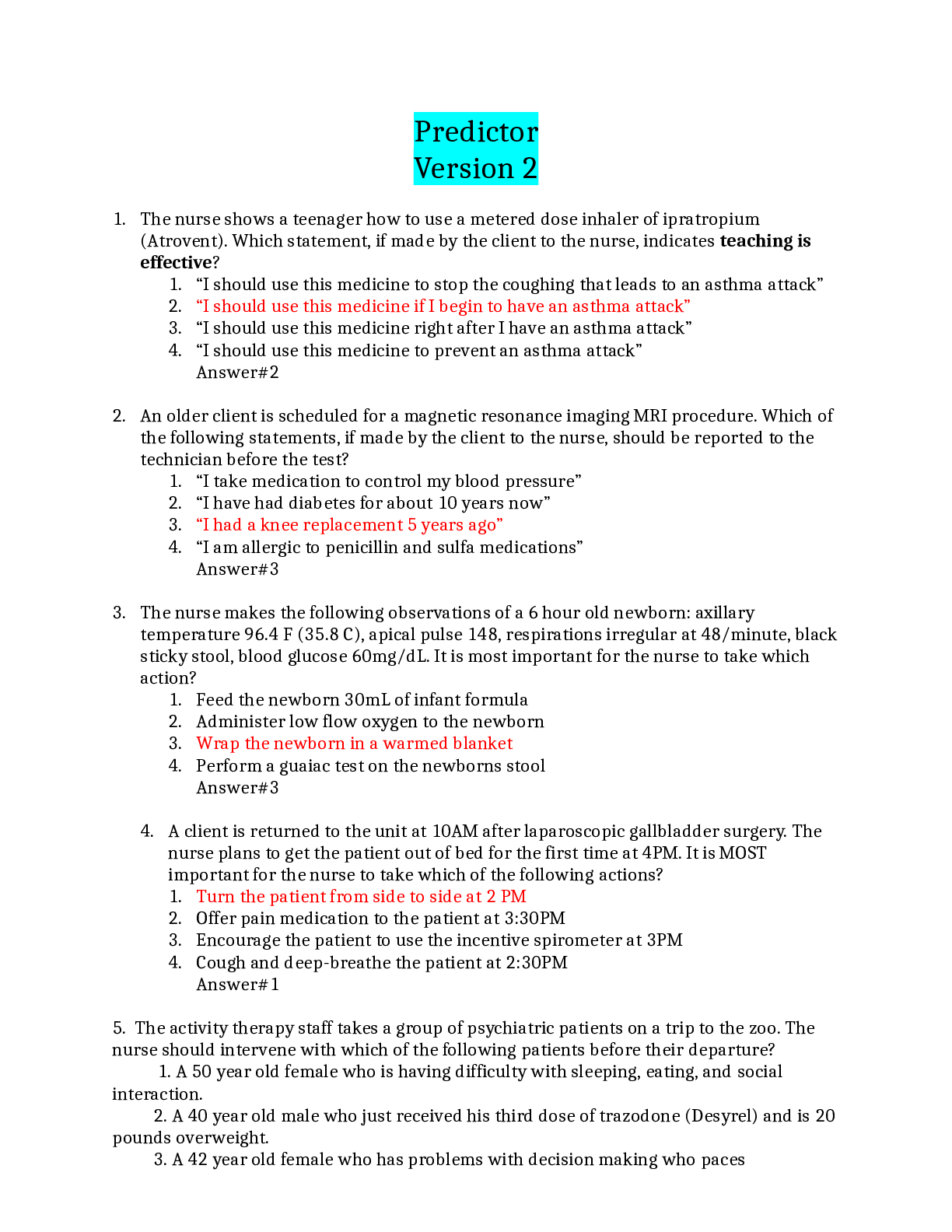
Reviews( 0 )
Document information
Connected school, study & course
About the document
Uploaded On
Aug 26, 2021
Number of pages
33
Written in
Additional information
This document has been written for:
Uploaded
Aug 26, 2021
Downloads
0
Views
51

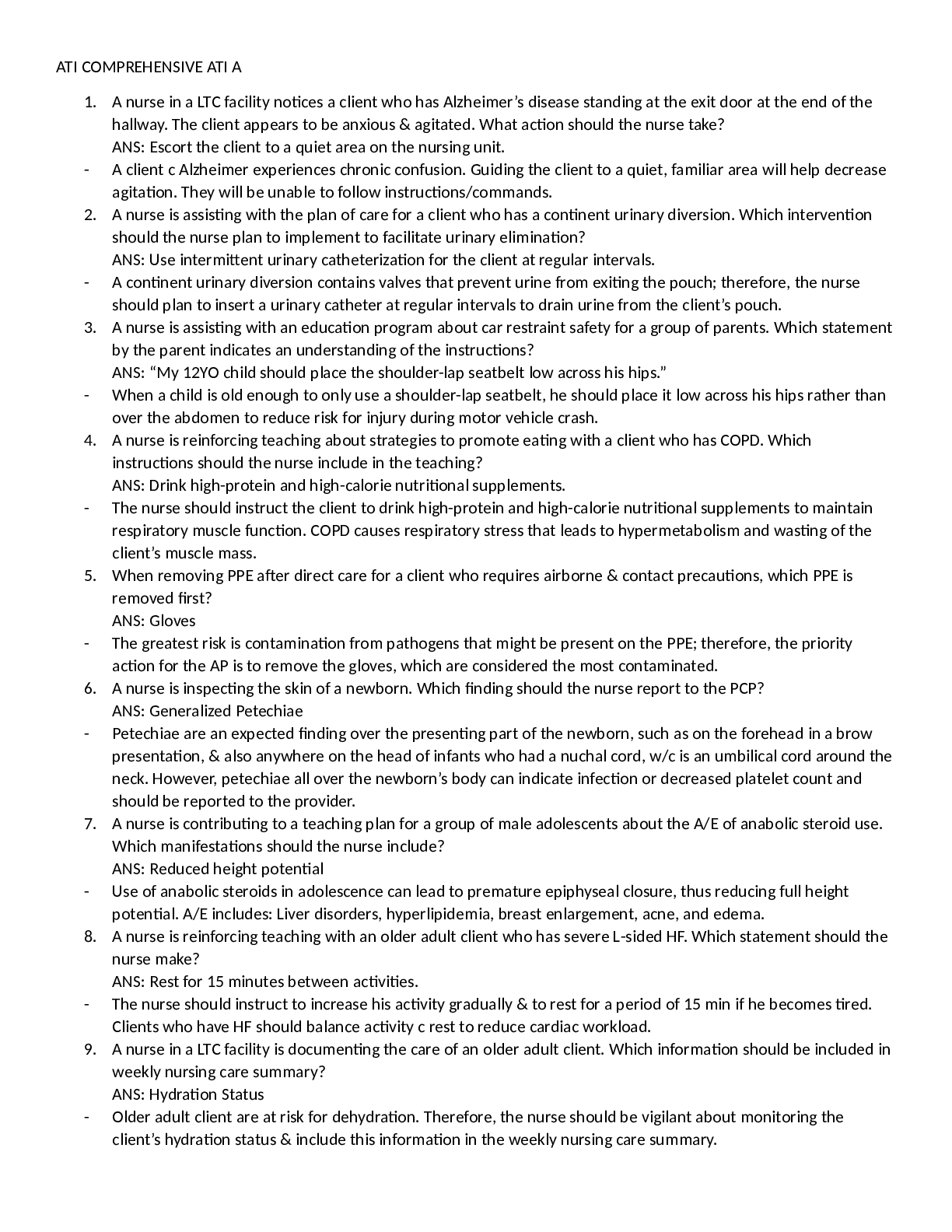
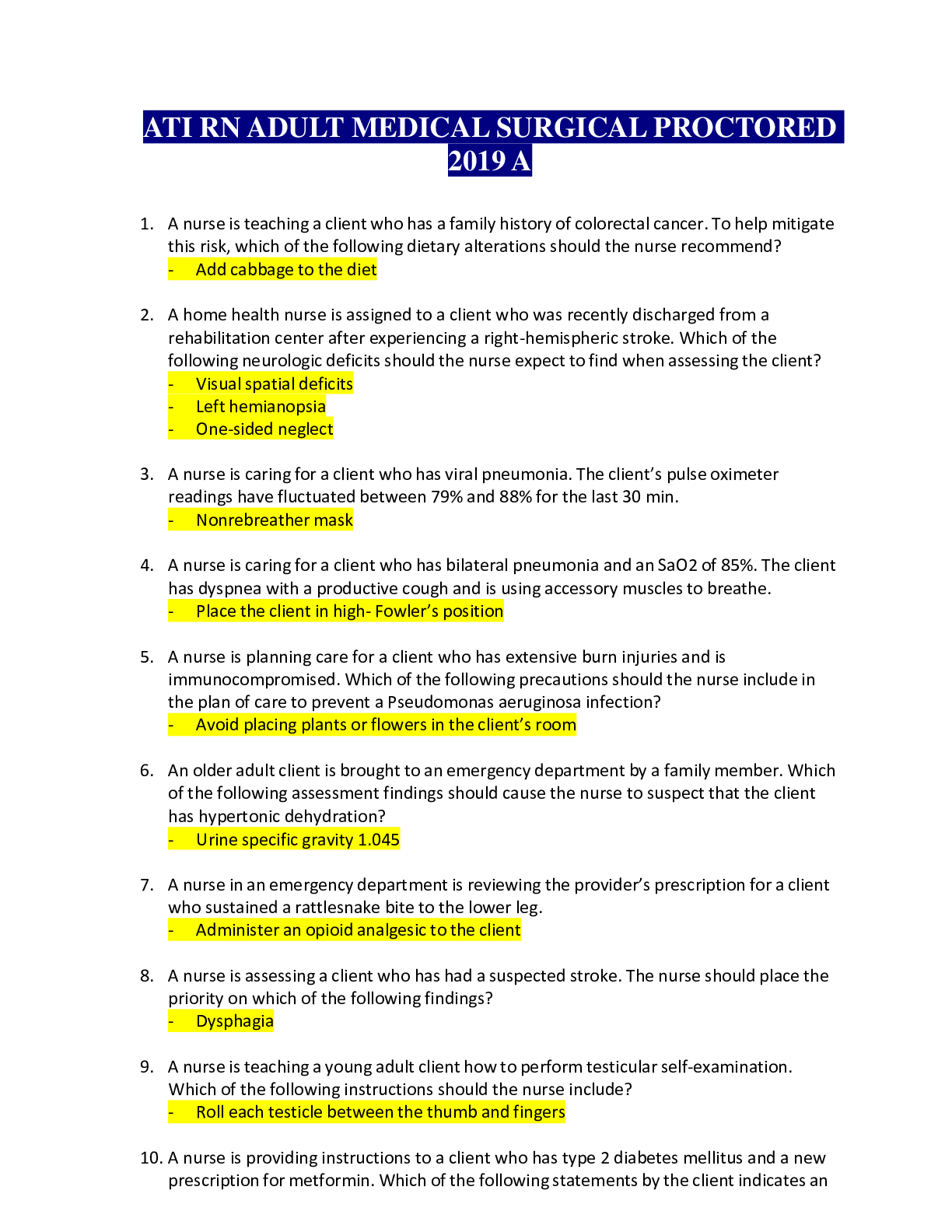
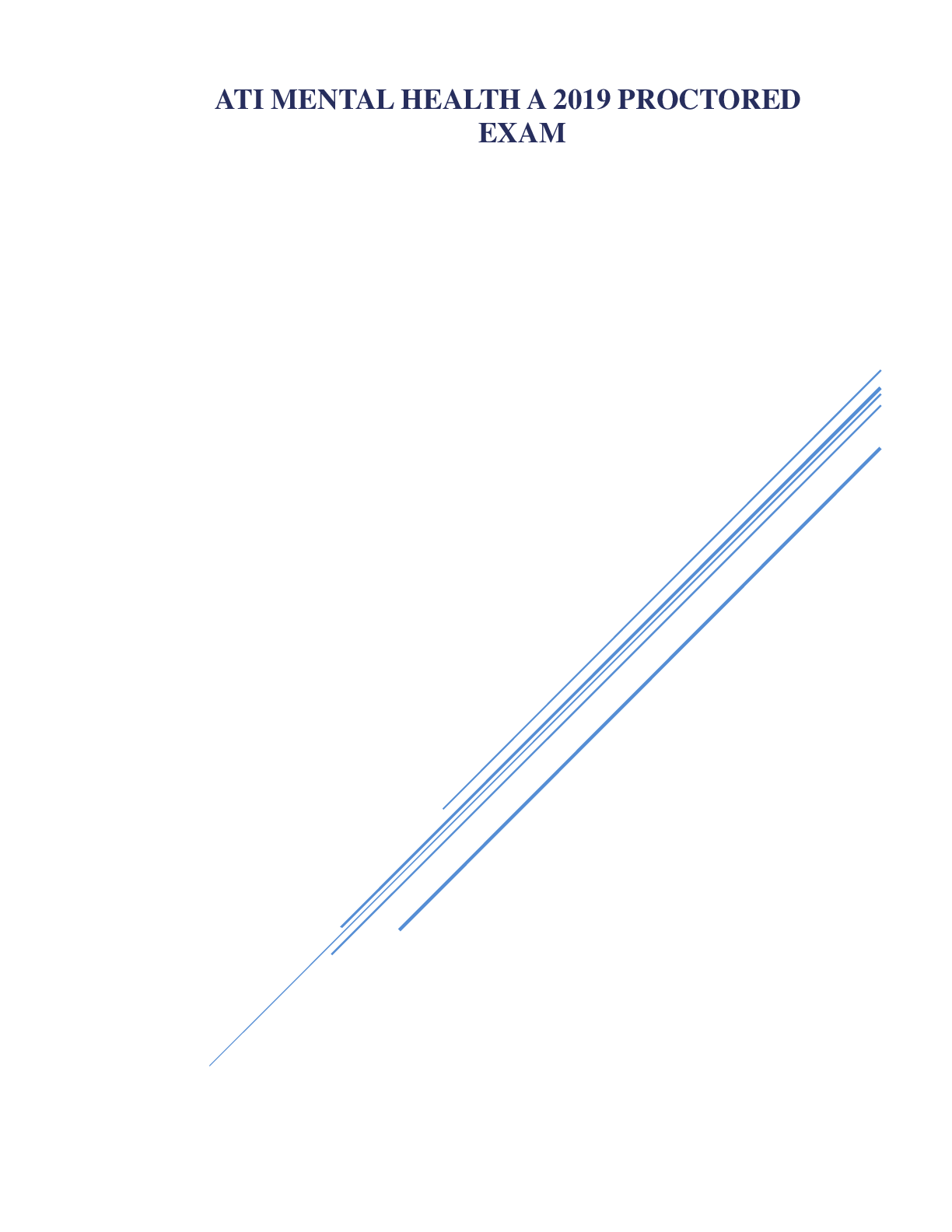
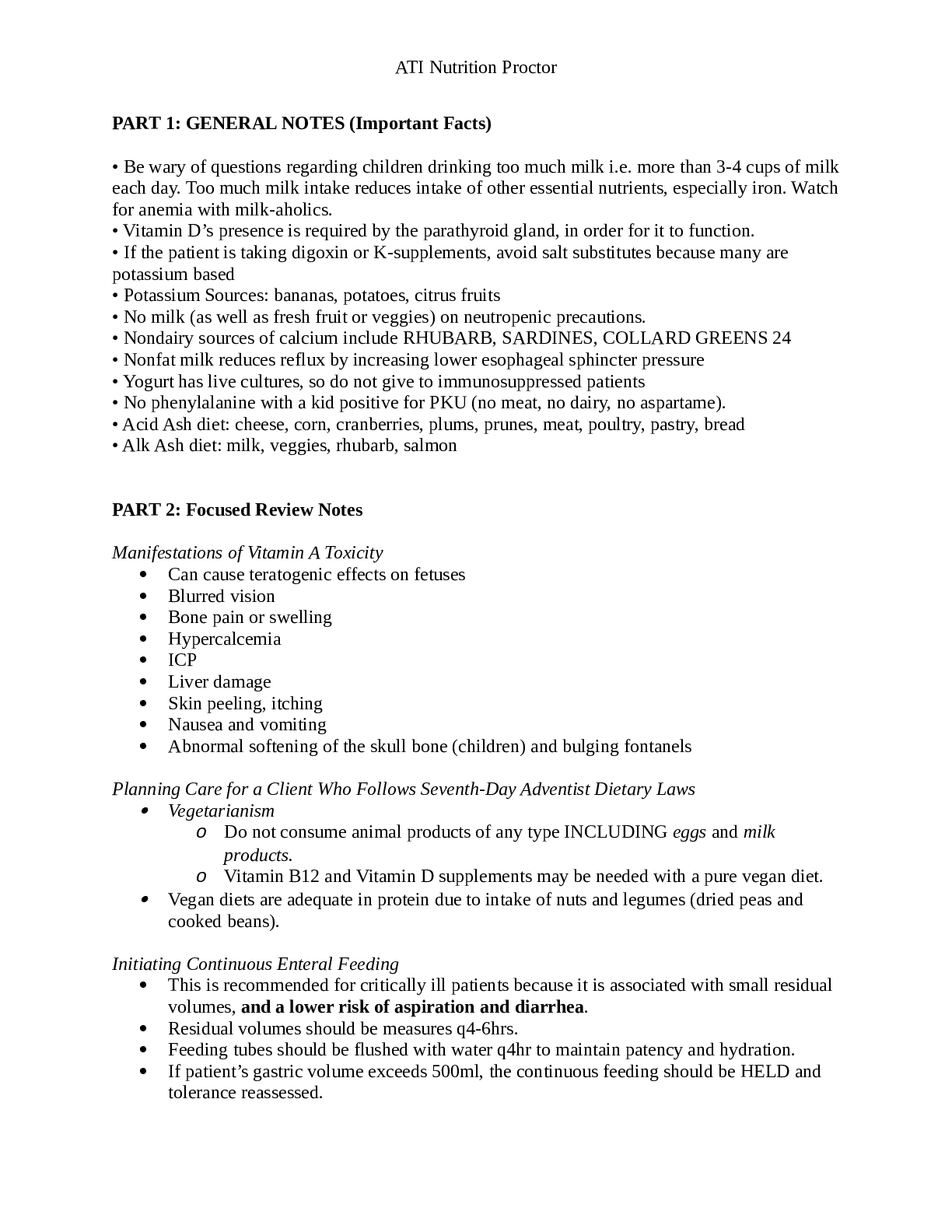

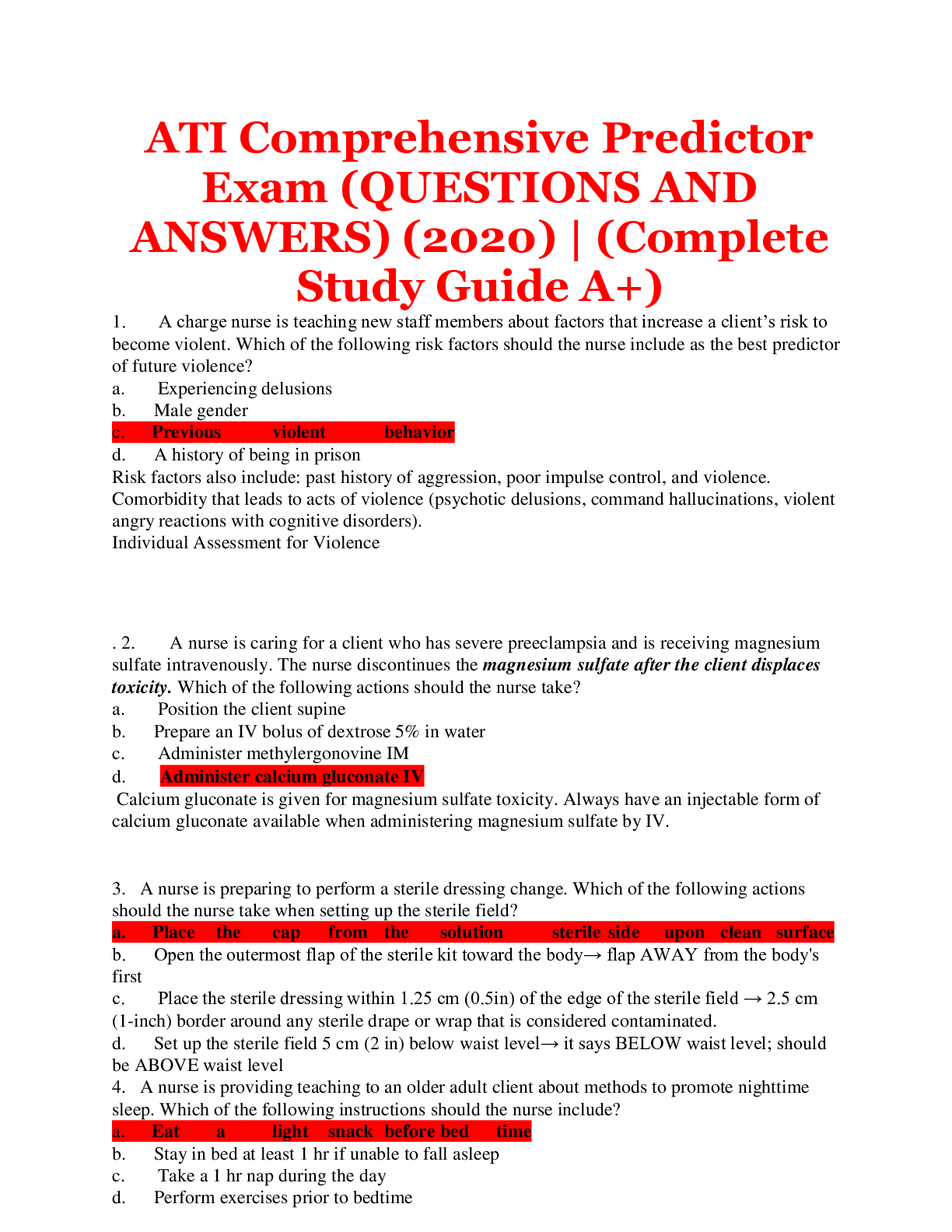
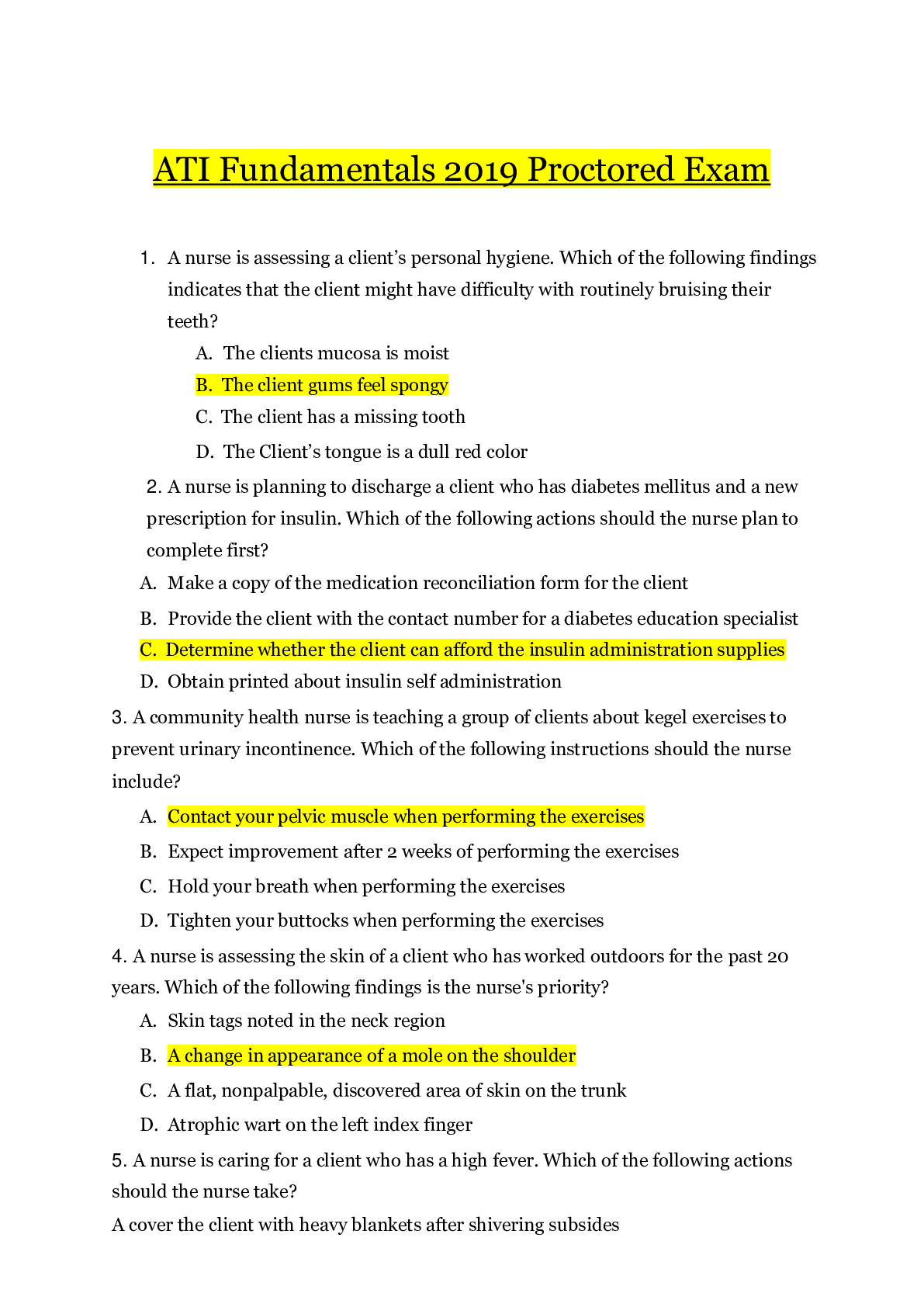
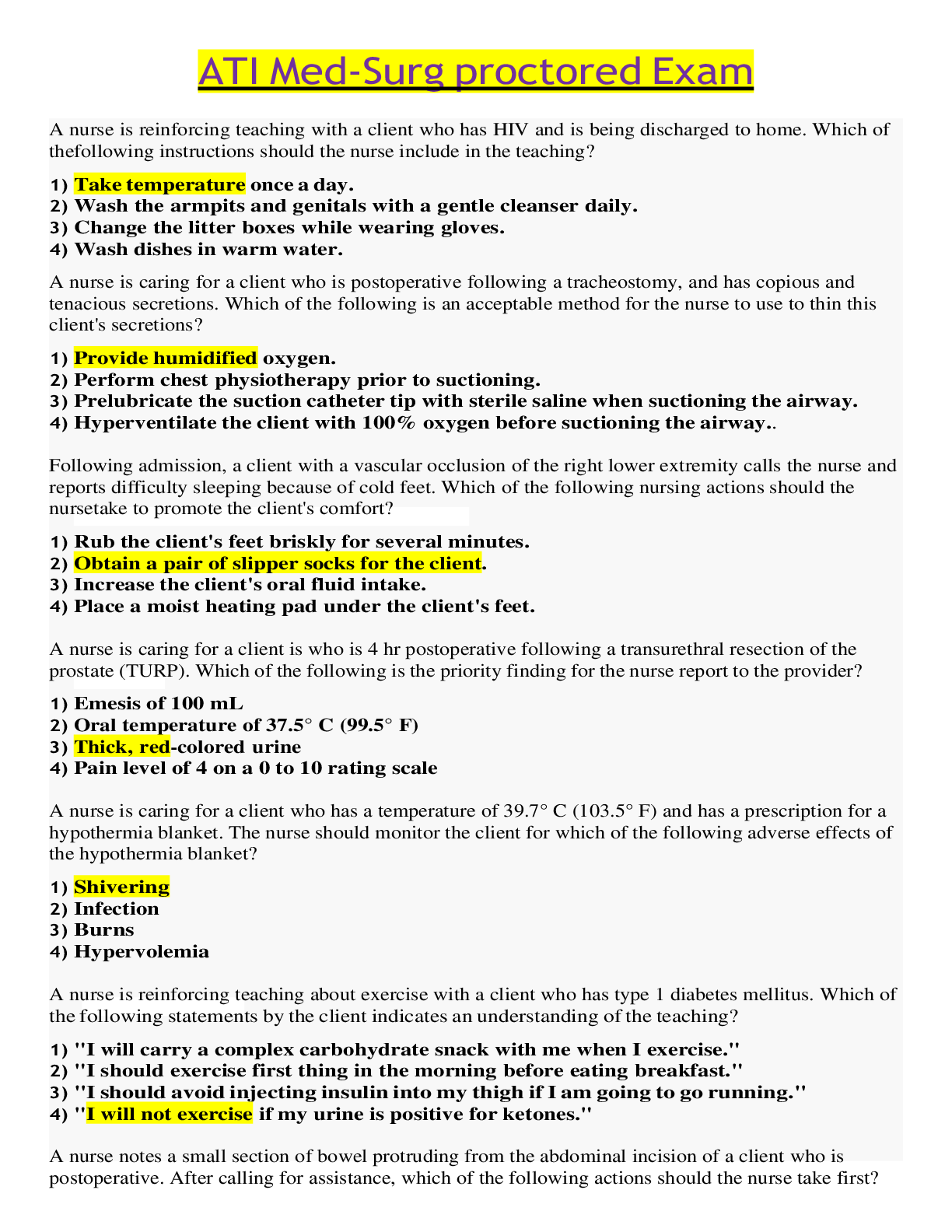
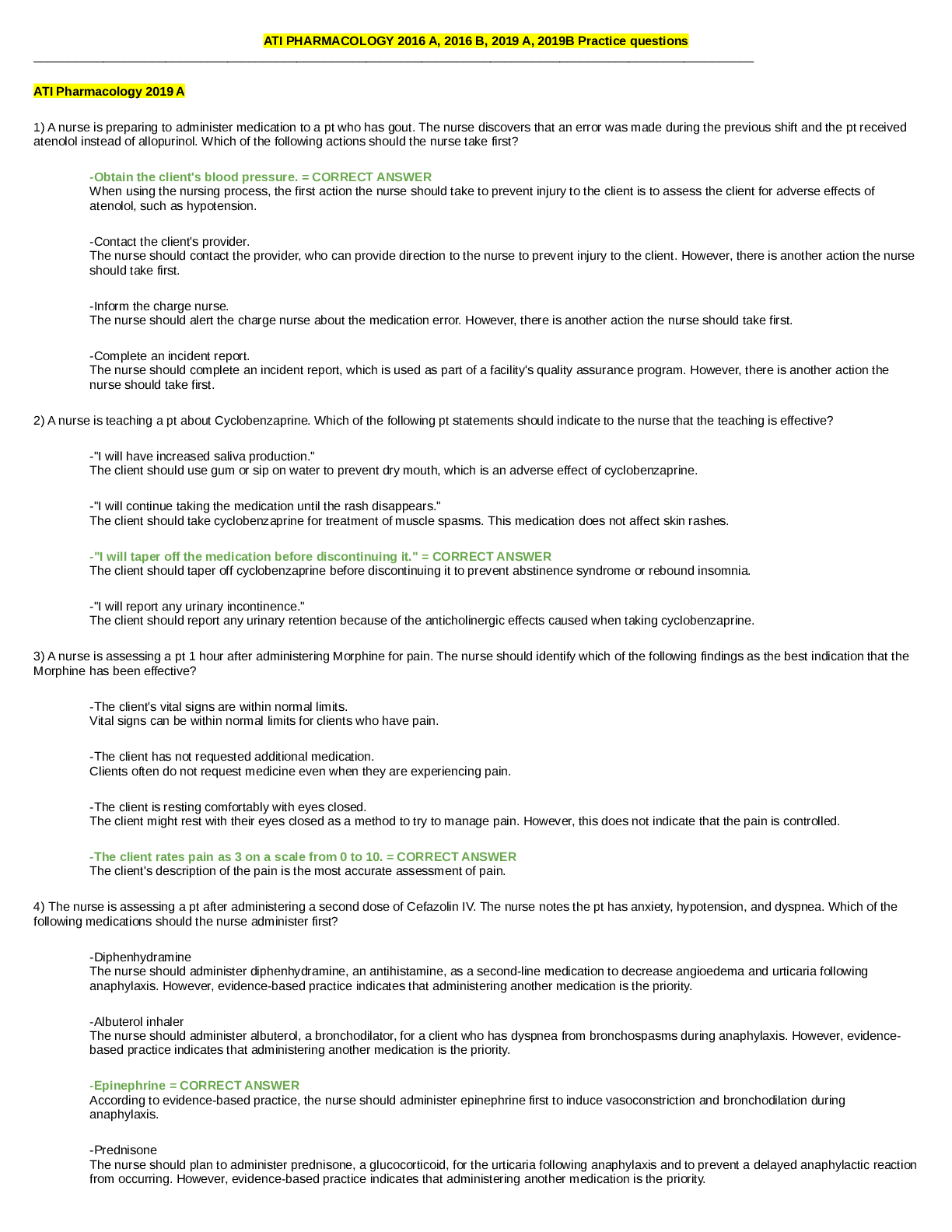
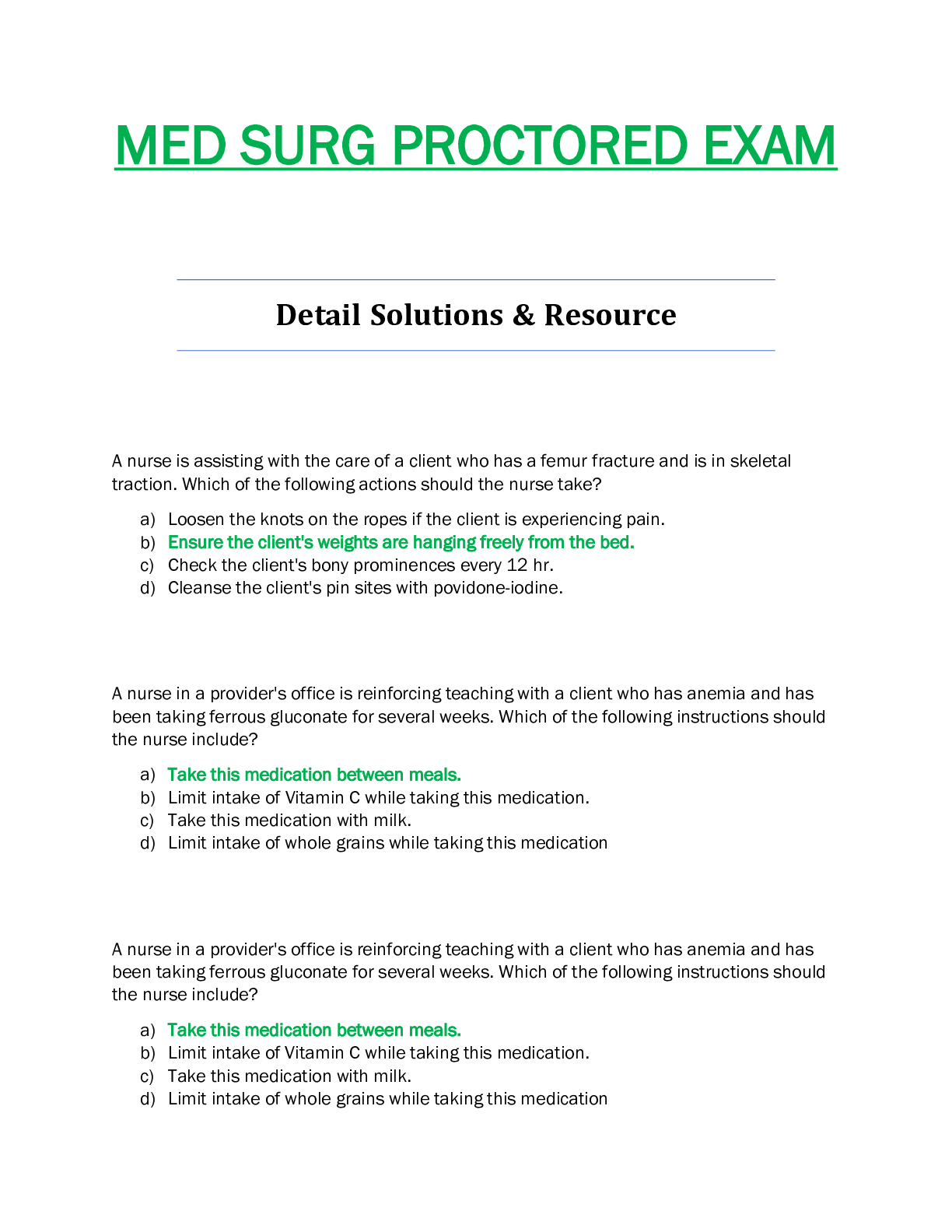
 – Miami Dade College.png)
